 Detour: The Via Romana
Detour: The Via RomanaS San Antón Monastery Ruins Km 452.5
S Ermita de San Nicolás at Puente de Itero Km 441.3
Villarmentero de Campos Km 417.5
Carrión de los Condes Km 404.2
Terradillos de los Templarios Km 377.8
San Nicolás del Camino Real Km 372
Ermita de la Virgen del Puente Km 366.9
Bercianos del Real Camino Km 353.9
Mansilla de las Mulas Km 327.4
Archaeological Site of Lancía Km 324.4
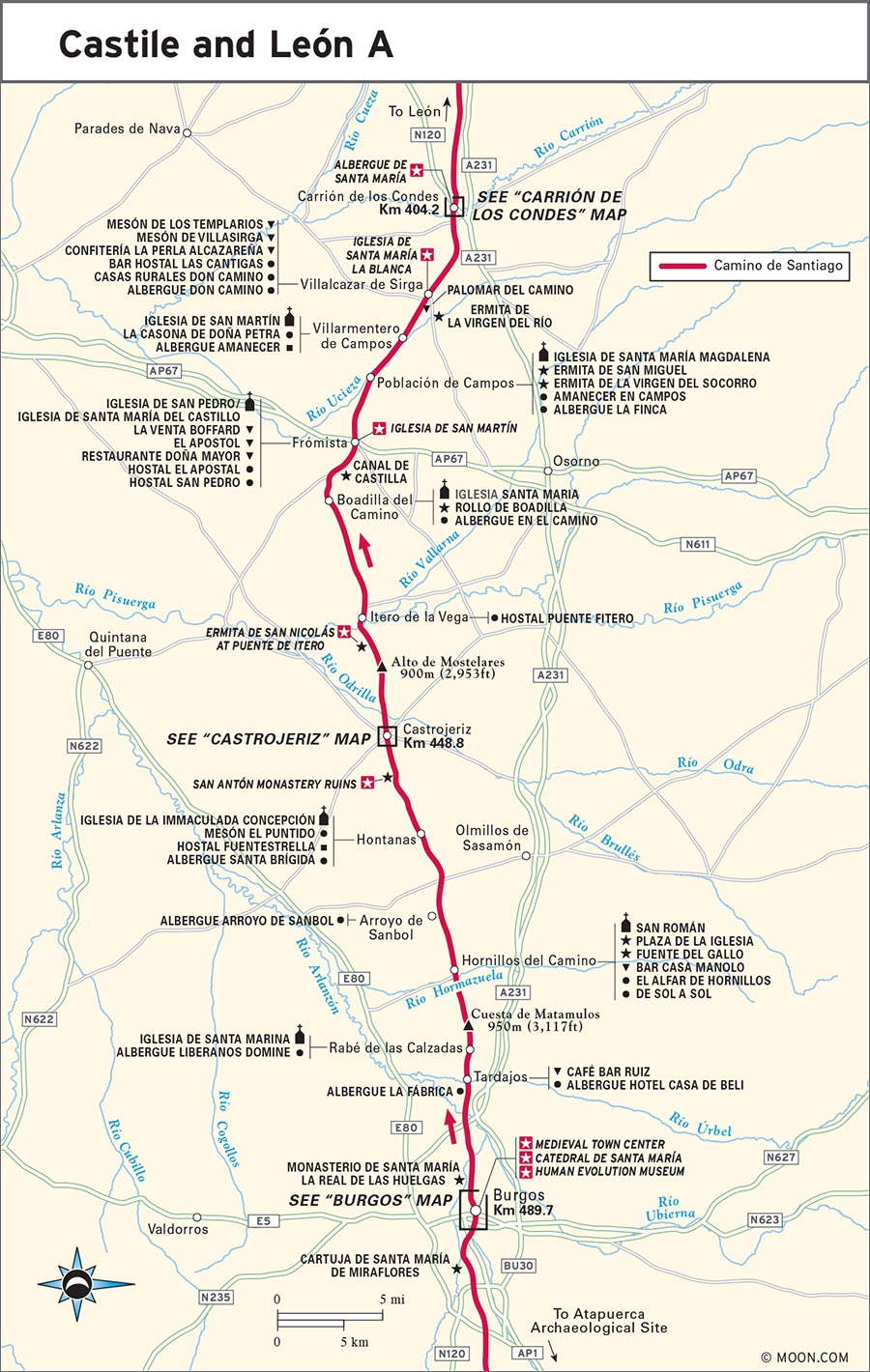
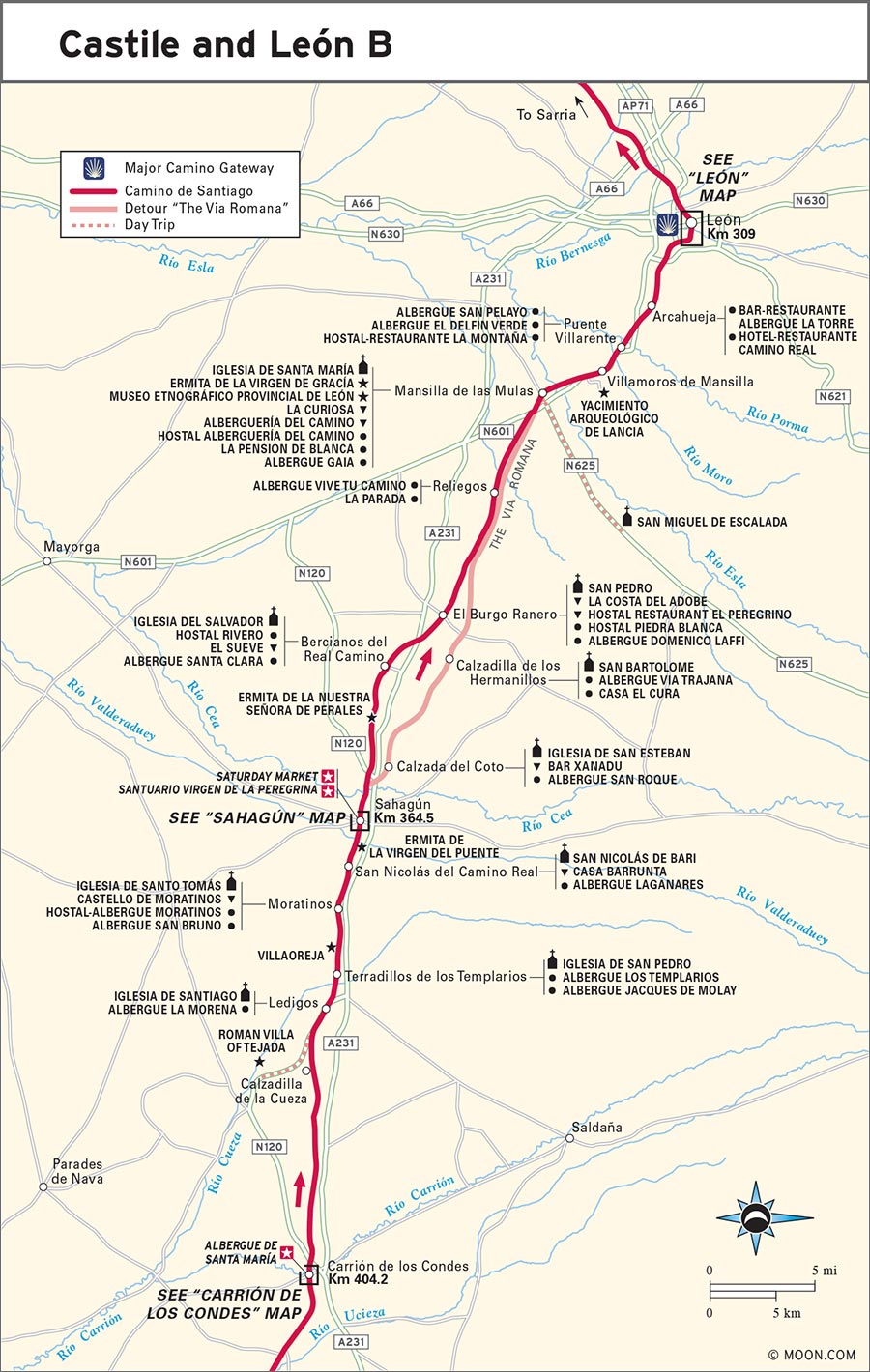
This is the classic meseta, the high plateau of Castile and León, framed perfectly between the two regal cities of Burgos and León. In stark contrast to the ascent and descent and forest cover of the first sections of the Camino, here it is all open sky and endless horizon—but with its share of wave-like rolling terrain, in some places 950 meters (3,117 feet) in altitude. The region has a beauty all its own. The wildlife here is stunning and, like pilgrims, is more active at dawn and dusk to cope with the intense sun, wind, heat, and cold. Look for clusters of white butterflies clinging, fast asleep, to vertical stalks of purple thistle, or frogs burbling in canals and creeks. If you get an early start, be sure to turn around and watch the sun rise from the eastern horizon in a rainbow swirl of orange, fuchsia, violet, and lavender.
The landscape of Castile and Léon brings to life the medieval knights and royal battles for power over Iberia, not only between the Christian north and the Muslim south, but also between the rival Christian kingdoms of Castile, León, Navarra, and Aragon. This is the territory of El Cid, a Castilian mercenary with an Arab nickname (al-sidi, meaning “lord” or “sir”) who fought on many sides, north and south. And here is another irony: As much as the region’s history depicts battles between Muslims and Christians, it also offers proof that those centuries were ones of creative flourishing, cohabitation, and diversity—convivencia. In Castile, more than anywhere else on the Camino, you will see the influence of Spain’s two other major faith communities, Muslims and Jews; It’s evident in the aesthetics of the churches and monasteries, especially in Burgos and Sahagún.
You are also now in core bodega country. (Bodegas are family wine cellars with underground passages dug into natural or manmade hills.) This is where each family makes and stores their annual wine, and also where they store other harvested and produced foods, from cheeses, sausages, and cured hams to grains, roots, and legumes. The entrance, the room nearest the surface, is often where friends visit the family and enjoy a drink, tapas, and meal. Each bodega has Hobbit-hole-like doors and icons around the entrance that seem both to decorate and protect the contents. Walking the Camino, you’ll pass many bodegas as you approach the villages and towns.
Walking the full 181-kilometer (112-mile) stretch of the Camino from Burgos to León will take 7-9 days if you average 20-25 kilometers (12.5-15.5 miles) per day. This pace allows time to explore a little each day.
Consider 1-2 days to explore Burgos, and a day to visit Atapuerca, Europe’s oldest site for human fossils. Add another day to make a detour from Mansilla de las Mulas to visit the rare 10th-century pre-Romanesque and Visigothic chapel of San Miguel de Escalada.
Two detours reduce the long tracts where the Camino runs parallel to the road after Frómista (Km 424). The first is an easy side-step, a few meters farther to the right of the road and the historic Camino, to follow the bank of the Ucieza river from Población de Campos (Km 420.6) to Villalcazar de Sirga (Km 409.8).
The second detour, 4 kilometers (2.5 miles) after Sahagún (Km 364.5), takes the path where once the Roman road, the Via Calzada (also called Via Romana and Via Trajana/Traiana), passed. This detour adds little by way of extra distance (less than 1 km/0.6 mi) but takes you away from the road along a 31-kilometer (19.2-mile) stretch, 17.7 kilometers (11 miles) of which lacks support structures. The two paths join as one again at both Reliegos (Km 333.7) and Mansilla de las Mulas (Km 327.4).
If you find yourself short on time, or if you want to bypass the unappealing industrial outskirts of León, you can get a bus from El Burgo Ranero, Mansilla de las Mulas, or Puente Villarente to León. You’ll gain about one or two days of walking, but unless you wait until Puente Villarente to get on the bus, you’ll miss the Roman archaeological site of Lancía, which is just after Mansilla de las Mulas. Another popular option to speed your journey is to bike from Burgos to León.
The route from Burgos to León traverses the bulk of north-central Spain’s meseta, a high plateau. This is big plains and big sky country, though there are still hills, especially on the stretch from Burgos (Km 489.7) to Boadilla del Camino (Km 429.7). After Boadilla del Camino, the terrain levels significantly and invites a new challenge—seemingly endless and unvaried terrain that can take pilgrims more deeply into their own thoughts.
The trail is well marked. Yellow arrows painted or engraved on stone and wood surfaces continue to guide the way, as do the knee-high stone pillars with engraved and stylized scallop shells. There is not a lot of walking parallel to a road in the first portion of this section, but from Frómista to León, about 50 percent of the historic Camino passes parallel to the road. Two detours significantly reduce this.
There are three other stretches where there are few or no support structures for more than 8 kilometers (5 miles): the 16.9-kilometer (10.5-mile) section from Carrión de los Condes (Km 404.2) to Calzadilla de la Cueza (Km 387.3); the 10.6-kilometer (6.6-mile) stretch from Sahagún (Km 364.5) to Bercianos del Real Camino (Km 353.9); and the 12.9 kilometers (8 miles) between El Burgo Ranero (Km 346.6) to Reliegos (Km 333.7).
The meseta is open, exposed, and often high-altitude plains that average around 850 meters (2,789 feet). This makes for a place of sweltering heat with little shelter or shade in summer that is equally exposed to wind, rain, snow, and frigid temperatures in winter. In spring and autumn, the climate can fluctuate, but generally these are the most pleasant and moderate seasons. If walking in summer, it is imperative to have sun protection and to carry plenty of water. It is also best to start walking early in the day and finish walking by early afternoon. In winter, bring layers. Days are shorter, and many places may be closed after October, so you will want to walk at the first sunlight; be ready to stop before the sun goes down, and be prepared to stay in hotels if albergues are closed.
The most popular starting point is Burgos, the second-largest city on the Camino, after Pamplona. The city is most easily accessed by train or bus. Another popular and well-connected starting point is midway, in Sahagún, which is most easily reached by train. El Burgo Ranero is a rare village with a transit hub on the meseta, connecting to León via bus and train.
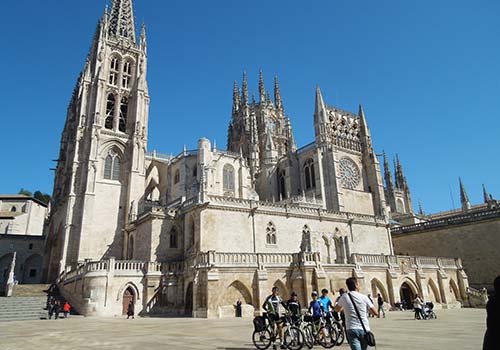
Camino bikers in front of the Catedral de Burgos
The east-west autoroute A-12/A-231 and N-120, named for the Camino, Autovía del Camino de Santiago, is never far from the walking trail between Burgos and León.
No convenient flights connect to Burgos’s municipal airport (RGS). The nearest airport is Bilbao (BIO; www.aena.es/es/aeropuerto-bilbao), coming from several destinations in the United Kingdom, France, and Germany, and from Brussels in Belgium and Lisbon in Portugal. Frequent bus and train departures connect Bilbao to Burgos.
RENFE (www.renfe.es) has several stops along this stretch of the Camino. The train has many connections from all points in the country and also has a line running along the Camino, stopping in Sahagún and El Burgo Ranero between its stops in León and Burgos. Frómista is also accessible via train from Madrid.
Monbus (www.monbus.es) and ALSA (www.alsa.es)—often working in concert—serve destinations between Burgos and León (including Castrojeriz, Frómista, Carrión de los Condes, Terradillos de los Templarios, and Mansilla de las Mulas). The bus is often the most efficient way to get around, as many locals in rural areas rely on this service to get to urban centers for work and shopping.
There’s also a direct bus from Madrid to Burgos.
Burgos (pop. 178,966) is a beautiful and prosperous city on both sides of the Arlanzón river. The medieval walls of the enclosed town are a dramatic backdrop to the river and a splendid atmosphere for the nightlife that it draws, especially on weekends. Inside the walled city and around the walls are several interesting churches, the most dominant being Burgos’s imposing cathedral, Spain’s third largest after Seville and Toledo. The other churches—San Lesmes, San Nicolas, San Gil, San Esteban, and San Águeda—offer more intimacy by contrast and are worth visiting for a better sense of what medieval Burgos felt like.
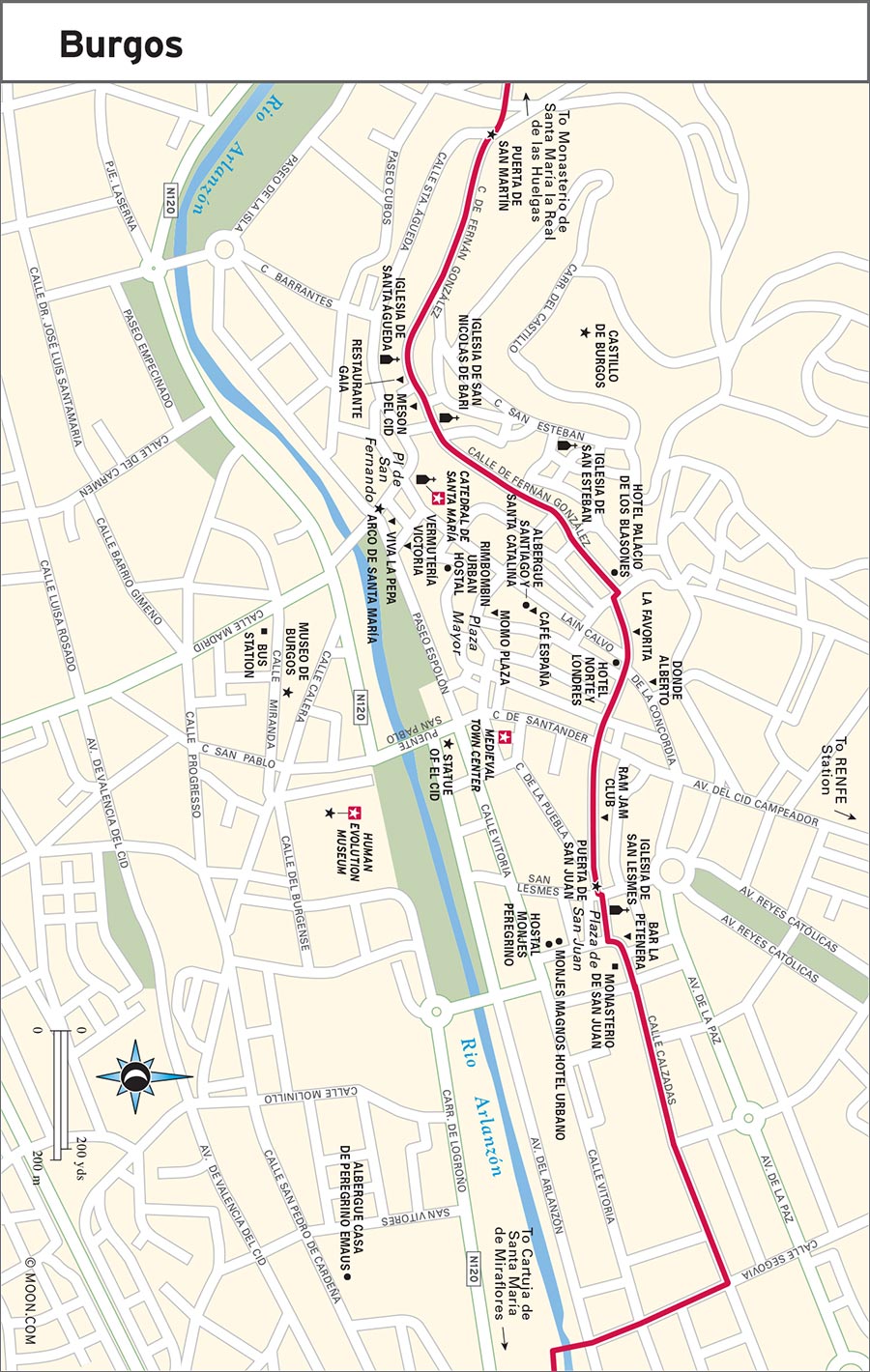
Burgos is also home to one of the world’s most important human evolution museums, thanks in large part to the nearby archaeological site of Atapuerca. It is also a university town and has a vibrant student population, with tapas bars, restaurants, outdoor cafés, and tree-lined walks and parks. Much of the action takes place along the river that flows through the city. All this makes the city an ideal place to explore for an extra day or two before returning to the Camino. The Camino itself passes through the heart of the medieval walled town, entering at Puerta de San Juan and exiting at the Puerta de San Martín.
Most of these sights are within the walls of medieval Burgos, easily navigated if you use the cathedral in its heart as your beacon. The exceptions can be accessed by using the river as your guide, from east to west, in this order: Cartuja de Miraflores; a small jaunt over the river to the Iglesia de San Lesmes; back again to the south bank for the Museo de la Evolución Humana; and then to the Monasterio de las Huelgas on the western end.
The 15th-century Cartusian monastery Cartuja de Santa María de Miraflores (Carretera Fuentes Blancas; 947-252-586; www.cartuja.org; Mon.-Sat., 10:15am-3pm and 4-6pm; Sun., 11am-3pm and 4-6pm; donation) is set on the edge of a lovely pine forest on the east end of town. Still inhabited by monks of the order who live in seclusion and solitude, the monastery church is nevertheless open to the public. Inside, you can view the tombs of Queen Isabel la Católica’s parents, King Juan II and Isabel of Portugal, in the center, and that of her brother, Alfonso, set in the wall. Her parents’ tombs, completed in 1498, are perhaps the most dramatic and elaborate of any royal tombs, with a series of symbols and figures surrounding the lifelike carved-marble images of the reclining couple, who rest on a raised star-shaped platform. The monks living here are known for their craftsmanship of rosaries made from rose petals. On Sundays the public can attend mass at 10:15am.
Adelelmo (who would be named Burgos’s patron saint, San Lesmes) was a French Benedictine monk who arrived in Burgos in the 11th century to dedicate his life to serving pilgrims in the monastery of San Juan, which was founded here. He died in 1097, and the present church, the Gothic and 15th-century Iglesia de San Lesmes (Plaza de San Juan, s/n; 947-204-380; www.aytoburgos.es; free), holds his tomb in the center of its nave. It is open daily, with several religious services throughout the day. Visitors are asked to limit sightseeing visits to before or after services.
After visiting the church, step outside onto the Plaza de San Juan. If you stand with the church to your left, you will face the Benedictine Monasterio de San Juan (947-205-687; www.aytoburgos.es; Tues.-Sat., 11am-2pm and 5-9pm, Sun., 11am-2pm, closed Sun. afternoon, Mondays and holidays), where San Lesmes and his order housed and cared for pilgrims. It is now an interesting art exhibit space, with a lovely enclosed garden that’s open to the public during opening hours. In spring, if you look up at the old bell tower from the plaza, you will likely see nesting storks raising their young. Just to the right of the old monastery is Burgos’s public library, the Biblioteca Pública, an ultramodern building that retains the Gothic door from the old hospital of San Juan.
Burgos’s charismatic town center is surrounded by thick medieval walls that jut up along the north bank of the Río Arlanzón, containing the cathedral in its heart and the castle above it. With churches and plazas anchoring the interior, vibrant eateries, and locals coming here for a paseo, you’re sure to be pulled in.
If you are walking the Camino, you’ll find the medieval town center simply by following the yellow arrows and scallop shells inlaid into the pavement. Enter the medieval walled city through the gate on the eastern side of town, Puerta de San Juan, just off the Plaza de San Juan, outside the walls. Once inside the walls, allow yourself to meander. All roads within the walls ultimately will take you toward the cathedral, and to its south, the Plaza Mayor, an appealing and unpretentious square, each building painted a different color, with many cafés, restaurants, and bars offering diverse options for eating or for relaxing in the sun at an outdoor table.

the colorful Plaza Mayor in Burgos.
From the Puerta de San Juan, the Camino moves past the north side of the cathedral and the Iglesia de San Nicolas de Bari (947-260-539; Monday-Saturday, 11am-2pm and 5-7pm; Sundays, before and after mass; €1.50, free on Mondays), a well-endowed 15th-century church once favored by Burgos’s merchant guilds. Off this street and up the hill lie the castle ruins, some towers still standing.
In the 9th century, the king of León, Alfonso III, built a small castle over the remains of an early Roman fortress. Early medieval Burgos formed around this castle and the fortification and protection it offered several surrounding villages, which were known as burgos, burgs. It was modified and expanded over the Middle Ages to defend the region from incursions, and survived reasonably intact until it was blown up by Napoleon’s troops in 1813.
Today, it’s worth the climb up the hilltop to see the archaeological site of the Castillo de Burgos (Cerro de San Miguel; 947-203-857; www.aytoburgos.es/direcciones/castillo-de-burgos; €3.70; Jul.-Sept., Sat.-Sun. 11am-8:30pm, 11am-2:30pm). The city has restored aspects of the castle, and you can see the outline of the medieval foundations and some of the walls and towers. There are also good displays that recreate the medieval world from this hilltop, plus a great view down onto the cathedral just below and the city all around.
Just below the castle is the Iglesia de San Esteban. It is rarely open, so enjoy the exterior of this survivor from the 13th and 14th centuries, with its lyrical side porch with thick timbered roof and playful animal engravings around the doorway arch—including a smiling rabbit running towards two scallop shells. Could he be a pilgrim?
For lovers of religious art, Burgos’s Catedral de Santa María (Plaza de Santa María; 947-204-712; www.catedraldeburgos.es; Mar. 19-Oct. 31, 9:30am-7:30pm, Nov. 1-Mar. 18 10am-6pm, closed Dec. 25 and Jan. 1; €7, €4.50 for pilgrims) is as much a museum as a place of worship, not to mention of pomp and politics.
Begun by King Fernando III in AD 1221, it was completed a mere 22 years later, a feat that gives the church its unified aesthetic. That Gothic structure was then added to and elaborated on, becoming the multilayered walk through Castilian history that you see today.
You can spend several hours here, exploring the many chapels, elaborately carved choir, cloister, and layers of medieval to early modern art. But whatever your timeframe, be sure to see these four highlights:
• Transept: The place in the church’s cross-shaped ground plan where the arms intersect is beautiful and symbolic. Destroyed by a fire three centuries after it was built, the current vault was reconstructed in 1568 by Juan de Vallejo, who was inspired by the Mudéjar—Iberian Muslim—art of Spain. In the center of the transept’s dome is an elegant filigree eight-pointed star, which lets in soft natural light. You’ve seen this same pattern in the reconstruction of the church of El Puy in Estella (if you have been walking from there), and you’ll see it again in the Constable’s Chapel beyond the apse here, too. The crossing also stands directly over a rose-toned marble stone, marking the tombs of El Cid (1043-1099) and his wife Jimena Díaz (1046-1116) underfoot. Their bodies have been here only since 1921, when they were moved here from the monastery of San Pedro de Cardeña just southeast of Burgos.
• Rose window: The west entrance’s rose window with its six-pointed star—a common decorative motif in Christian, Islamic, and Jewish art—is ethereal and beautiful when viewed from the nave. It can represent many things, but top among them is the Seal of Solomon, symbol of a just and wise ruler. His seal also represents the force of heaven intersecting with that of earth, as with justice and wisdom, creating a perfect harmony. From the nave, you will also find the ornately carved wooden choir, built in the 16th century. At that time, it was the style in Spain to set these in the center of earlier churches, obstructing the full line of the nave. While that is unfortunate, take time to look closely at the interesting characters in the engravings. Some are humorous, expressive, and highly animated.
• Capilla de Condestable: The octagonal Constable’s Chapel is just behind the apse. This is an incredibly ornate Gothic to Renaissance space, largely from the 15th and 16th centuries. Look for the detailed tombs of Burgos’s first constable and his wife, Don Pedro Fernandez de Velasco and Doña Mencía de Mendoza, then take a look up at the chapel ceiling to see the Gothic-Mudéjar-fusion eight-pointed star. Similar to the Mudéjar-inspired star in the transept, this one precedes it and is by the late 15th-century architect Simón de Colonia.
• Cloister: Saunter through the late-13th- and early-14th-century Gothic cloister. Largely original, it offers a more serene and organic experience of the cathedral.
Iglesia de Santa Águeda (Calle Santa Águeda; 947-206-755; Mon.-Wed., 12-1pm and Thurs.-Sat., 5:30-7pm; free), west of the cathedral, is where in AD 1072 El Cid made his patron, King Alfonso VI of León (and imminently also King of Castile), swear that he played no role in the murder of his brother, King Sancho II of Castile. You’ll see this history forged in ironwork on the outside entrance door’s lock, an image of an altar with El Cid on one side holding his sword, and Alfonso VI on the other wearing the king’s crown. The current church, also known as Santa Gadea, is Gothic and from the 15th century, built over the 11th-century site.
The iconic passage of the Arco de Santa María was the main entry gate into medieval Burgos during the 14th century. Its present ornate and flamboyant appearance come from the 16th century, when the Hapsburg king of Spain, Carlos V, commissioned the building of a larger gate, its decoration directed toward the imperative that citizens be loyal to the crown.
If you return back to the Camino’s passage through the medieval town and follow it west, it eventually exits at the Puerta de San Martín, which marks the general vicinity where Burgos’s medieval Jewish and Muslim neighborhoods once stood. Though San Martín’s gate is a reconstruction, it retains the signature Mudéjar brickwork of Iberia’s Muslims (you’ll see more of this in Sahagún). Recent archaeological excavations around the gate of San Martín have revealed many layers of the city’s history, including tiles that date to the medieval Muslim neighborhood and structures related to the medieval Jewish one, one of Iberia’s most important Jewish communities. From here, the Camino meanders through city-park-lined neighborhoods and onward to the plains.
One of the world’s most important museums on human evolution, the Museo de Evolución Humana (Paseo Sierra de Atapuerca, s/n; 902-024-246; www.museoevolucionhumana.com; €6) showcases finds from the nearby Atapuerca archaeological site, a layer cake of human existence in Europe. The museum contains artifacts from over a million years ago, especially highlighting the earliest humans, Homo antecessor, who lived here 1.2 million to 800,000 years ago, and Europe’s earliest Neandertals, around 400,000 years old.
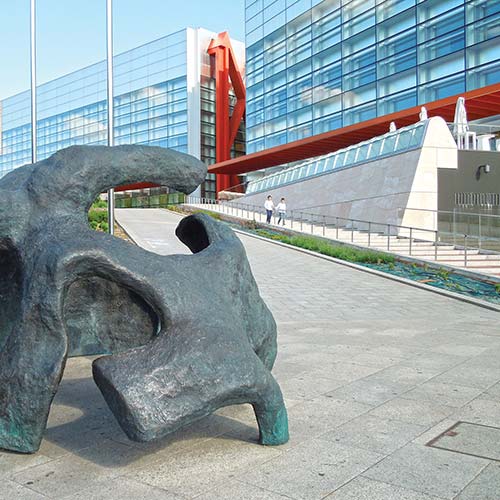
Museo de Evolución Humana in Burgos
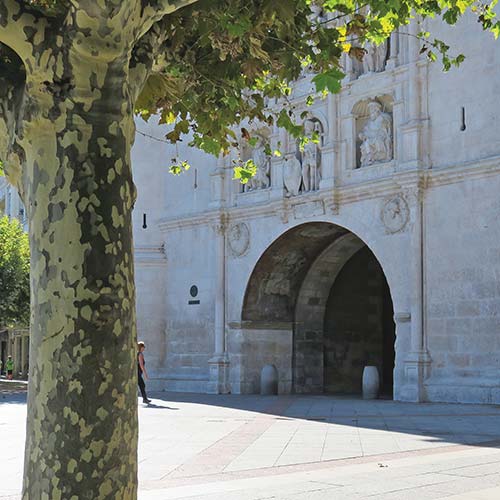
the Arco de Santa Maria entrance gate into the walled center of medieval Burgos
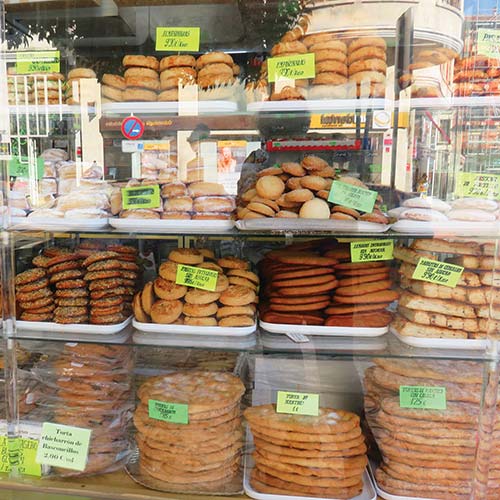
bakery shop window in Burgos
This museum is also an important center for research about human evolution. Exhibit spaces are engaging, creative, and interactive: Experience a simulated brain as it fires off neurons for functions such as speaking, then learn about early human art and why we create these symbolic forms of communication. Descriptive panels are also in English.
The museums opening times are: Oct.-June, Tues.-Fri., 10am-2:30pm and 4:30-8pm; Sat., weekends and holidays, 10am-8pm; July-Sept., 10am-8pm. Admission is free on Wednesdays from 4:30-8pm and Tuesdays and Thursdays from 7-8pm; closed Mondays. General admission includes entrance to the nearby Museo de Burgos (Calle Miranda, 13; 947-265-875; www.museodeburgos; Oct.-June, Tues.-Sat., 10am-2pm and 4-7pm, July-Sept., Tues.-Sat. 10am-2pm and 5-8pm, Sundays, all year, 10am-2pm; €1), which also displays archaeological remains from the area, from the Paleolithic era through the Roman period and into the medieval era. It also houses a good collection of 19th- and 20th-century art.
Founded in AD 1175 on the land of one of Castilian king Alfonso VIII’s country palaces, the Monasterio de las Huelgas (Calle de Compases, s/n, 947-201-630; www.patrimonionacional.es/real-sito; open Tues.-Sat., 10am-2pm and 4-6:30pm, Sundays and holidays, 10:30am-3pm; €6) was Cistercian from the start and a convent for women from the nobility. Its abbess was powerful and oversaw several towns and other Cistercian monasteries. Las Huelgas was also the site of Castile’s royal pantheon, tombs that you can visit today, where kings were crowned and knights knighted. Not only was it the center of Castilian royal and religious power, it remains a treasure of Mudéjar architecture blended with the complex’s Romanesque and Gothic, reflecting convivencia—mixing and living together in harmony—over conflict.
The Mudéjar influence is clear in the tomb engravings, as well as in the roof and ceiling woodwork of the cloisters, the lacey plasterwork on the walls of the Capilla de la Asunción and the Capilla de Santiago, the multi-lobed archways of the former and the inlaid wooden ceiling of the latter, among many other spaces.
Today Las Huelgas remains an active Cistercian convent, with 32 nuns carrying on monastic life and service (www.monasteriodelashuelgas.org).
Every Wednesday and Saturday (9am-2pm) the weekly produce market sets up on the east end of town along the Calle El Plantío, running parallel along the north bank of the Río Arlanzón—midway between the Cartuja de Miraflores and the Human Evolution Museum, though these landmarks are on the south bank. Every Sunday (10am-2pm) is Burgos’s flea market, El Rastro, on the Plaza de España, to the northeast of the castle and cathedral, where you can browse antiques, books, stamps and old coins, among other things—something like an open-air ethnography museum of daily life from a bygone era. Open-air textile, clothing and shoe markets also set up Wednesdays (Parque de los Poetas; 9am-2pm), Fridays (Paseo de Empecinado; 9am-2pm), and Sundays (Calle El Plantío; 9am-2pm).
S Meson del Cid (Plaza Santa María, 8; 947-208-715; €35) has large windows overlooking the cathedral from the Plaza de Santa María and an interior of medieval-style stained-glass windows, ceramic tiles, and crisp white linens. This is the place to try Burgos’s famous morcilla (blood sausage), either on its own or in alubias rojas de Ibeas (a red bean stew with morcilla and chorizo, €9.90). Other signature dishes are the roast lamb (€23), the high-quality jamón Iberico de bellota (acorn-fed, free-range cured ham), and clams and artichokes simmered in white wine and herbs.
With its casual country décor, white wood walls, and contemporary cuisine emphasizing fresh, local, and healthy, Viva La Pepa (Paseo del Espolón, 4; 947-102-771; www.vivalapepaburgos.com) feels a bit like California. (Check out their smoothies or their tofu and spring greens salad.) They have an elaborate breakfast menu (€3-10) that is unusual in Spain, plus tapas (€7-10), lunch (€13.50), or dinner (€18-26). Though the address is on Paseo Espolón, the gardened promenade on the riverside, it has an entrance on the other side from the Plaza del Rey San Fernando, which faces the cathedral.
S Momo Plaza (Plaza Mayor, 16; 947-250-423; €5-12) offers excellent regional wines to go with their creative and tasty array of pinchos, such as beef-and-onion-stuffed mushrooms, red peppers filled with cod and hot sauce, and mussels stuffed with minced tomatoes, onions, and bread crumbs, then deep fried. They also make superb cocktails.
La Favorita (Calle Avellanos, 8; 947-205-949; www.lafavoritaburgos.com; €12-20) has beautiful stone and brick walls, elegant white tablecloths, and an immense bodega—wine cellar—with a wide selection of wines. They serve plates of regional cheeses and several kinds of Ibérico cured hams, grilled blood sausage (morcilla), salads, omelets, fois gras cooked in port, and a variety of grilled meats and vegetables.
Restaurante Gaia (Calle de Fernán González, 37; 947-279-728; €11) caters to vegetarians, offering something for nearly every taste thanks to a world-cuisine approach with inspired ideas, diverse ingredients, and bold spices and seasonings.
S Bar La Petenera (Plaza de San Juan; €5-10) is tucked in behind the Iglesia de San Lesmes (apse side) on the Plaza de San Juan. The setting alone makes the bar a place to visit, but the delicious pinchos, upbeat servers, and friendly customers will all keep you here. Bar La Petenera feels more like secret neighborhood spot than a tourist attraction. On warm days and evenings, the bar expands with outdoor seating into the plaza.
Donde Alberto (Plaza Alonso-Martínez, 5; 637-016-461; €4-10) is run by the ever-cheerful and upbeat Alberto, who also makes the fresh and innovative pinchos that line his counters from one end to the other. Everything is amazingly inexpensive. There is a wide selection of wines. It can get pretty crowded at night, but midday can make for a good lunch venue with fewer people.
This university town is alive with evening and weekend energy. The medieval town center is a major hub for multi-generational nightlife, and in many venues, even the Ram Jam Club, you’ll see people of all ages. Nearly everyone is out for the evening paseo to enjoy the squares and cafés, and to meet up with friends for a drink, an activity that flows seamlessly into a long night of hopping from one tapas bar to the next. If you meander through the Plaza Mayor and cathedral areas, as well as around the Puerta de San Juan and the riverside cafes around the Arco de Santa María, many of which also open on to the Plaza de San Fernando, you will come upon many enticing places to stop and enjoy the flow.
To join the vermouth resurgence in Spain, and especially Castile, head to Vermutería Victoria (Plaza Rey San Fernando, 947-204-281). Founded in 1931, the bar and dining room is an energetic mix of turn-of-the-century Belle Époque floral plaster carved walls and ceiling, classical paintings, and big-band music surging through the vermouth-laced air. As vermouth is considered a pre-dinner aperitif and you are in Spain, anytime before 10pm you’ll find the place festive and packed.
Ram Jam Club (Calle San Juan, 29; 629-709-447) is casual with a mellow, café-society feel, where a good selection of inexpensive drinks combines with rich conversation as well as occasional live music. It can get more pulsating during weekends, and is popular with students as well as music lovers of all generations. You can’t miss it for its clock sculpture at the entrance, the hour numbers all reading 6, and the wavy lines of the hour and minute hands implying that time can be left at the door. It is also a venue for the cider festival, Fiesta de Sidra, which takes place around the summer solstice in June.
Café España (Calle de Lain Calvo, 12; 947-205-337; www.cafeespana.es) is a classy place holding down the same spot since 1921. Known for its wide variety of coffee drinks, some straight-laced and others spiked, several evenings a week the café can turn out live blues, jazz, and flamenco. Sundays are Poesía y Música nights, where literature and music combine into a soiree of readings, performances, and discussions.
Albergue Casa de Peregrino Emaus (Calle San Pedro de Cardeña, 31a; 947-205-363; Easter-Nov. 1; 20 beds; €5) is a recently opened ecclesiastical albergue. Clean, well-run, and welcoming, it is popular among pilgrims and is an inexpensive place to stay in the city. It also has a good communal meal, based on donation, and a small chapel with evening service.
Albergue Santiago y Santa Catalina (Calle Lain Calvo, 10; 947-207-952; Mar.-Nov.; 16 beds; €6) is also known as the Albergue Divina Pastora because of its ideal location just above the chapel, Capilla de la Divina Pastora, a stone’s throw from the cathedral. They have eight bunk beds, for walking pilgrims only, in their simple but clean and uncrowded single-room dormitory.
Hotel Palacio de los Blasones (Calle Fernán González, 10; 947-271-000; www.hotelricepalaciodelosblasones.com; €90-100) is in an old palace in the heart of the pedestrian medieval town. With beautiful thick stone walls and simple decor, it’s a lyrical merging of past and present.
Hotel Mesón del Cid (Plaza de Santa María, 8; 947-208-715; www.mesondelcid.es; 49 rooms; €65-75), located in a stunning setting right in front of the cathedral, offers consistent high quality. Rooms are colorful, spacious, and simply but tastefully decorated, with spacious modern bathrooms.
S Monjes Magnos Hotel Urbano (Calle Cardenal Beniloch s/n; 947-205-134; www.monjesmagnoshotel.com; €50-70, call to inquire about special pilgrim prices not advertised online) offers several options at different price ranges. Ismael Díaz Peña takes great pride in running a welcoming and efficient place, which is geared toward pilgrims as much as other visitors. Clean and modern, the hotel is right on the square near the pilgrim church of San Lesmes, and the surroundings are fetchingly historic. On weekends in the warm season, many weddings take place on the facing Plaza de San Juan. Proprietors speak English.
Just around the corner is the Hostal Monjes Peregrino (Calle Bernabé Pérez Ortiz, 1; 947-205-134; www.monjesmagnoshotel.com), run by the same English-speaking management as Monjes Magnos. The hostal is expressly outfitted for the pilgrim while still offering the comfort of private rooms with baths. Rooms are spare but elegant and airy, with large beds. Common areas have spaces to gather for food and drink. There is a gym, in case you haven’t walked enough.
Hotel Norte y Londres (Plaza Alonso Martínez, 10; 947-264-125; www.hotelnorteylondres.com; 50 rooms; €50-65), founded in 1904, is a classy boutique hotel overlooking a sweet little square in the medieval center of town. Some rooms have glass-enclosed balconies looking out on the Plaza Alonso Martínez. Warm, professional, English-speaking staff are ready to assist.
For something a little different, the Rimbombin Urban Hostal (Calle Sombrerería 6; 947-261-200; www.rimbombin.com; €55) is deep in pedestrian Burgos between the cathedral and the river. Modern, airy, and light-filled rooms have private baths. A communal kitchen and salon are convenient if you want to gather provisions from Burgos’s produce markets and have a meal in.
Burgos is a transit hub, and is well connected to the rest of Spain by all modes of ground transportation. The most convenient and easy ways to arrive are by train and by bus.
If you are driving the Autovía del Camino de Santiago, the romantically named east-west A-12/N-120 highway from Pamplona to Burgos (and onward to Santiago), your entry into Burgos will be on the east side on the N-120. The whole drive on the N-120 from Pamplona to Burgos is 200 kilometers (124 miles, 2.5 hours). From San Juan de la Ortega to Burgos it is 30 kilometers (19 miles, 30 minutes).
Burgos is 246 kilometers (153 miles) due north of Madrid on the A-1, 158 kilometers (98 miles) southwest of Bilbao and 214 kilometers (133 miles) southwest of San Sebastián on the AP-68 and A-1, and 606 kilometers (377 miles) west of Barcelona via Zaragoza on the E-90 and E-804.
Burgos has a vast array of car rental companies, including Thrifty (www.thrifty.com), Dollar (www.dollar.com), Hertz (www.hertz.com), and Avis (www.avis.com). The RENFE station also has car rentals with Enterprise (www.enterprise.es) and Gavis (www.gavis.es). The next municipality along this section of the Camino with rental agencies is León.
RENFE trains (www.renfe.com) connect to Burgos from Madrid (3-5 daily, 2.5-4.5 hours, €35), Bilbao (3-4 daily, 2.5-3 hours, €14-19), Barcelona (3-7 daily, 6-8.5 hours, €45-114), and Pamplona (2-4 daily, 2-4 hours, €14-21), among many other destinations. Burgos’s large and ultra modern Rosa de Lima Station is five kilometers (3.1 miles) north of the city. When you arrive, taxis into town (€12-15) can be shared with 2-3 other passengers, and bus shuttles (€2) transport passengers hourly to the city.
If traveling by train from Burgos, you can purchase train tickets in the city center at the RENFE office (Calle Moneda, 23, 947-209-131; Mon.-Fri., 9:30 am-1:30pm and 5-8pm, Sat., 9:30am-1:30pm, closed Sun. and holidays).
Unlike the new train station, Burgos’s Estación de Autobuses (Calle de Miranda, 4; 947-265-565) is super-central, set in from the south bank side of the Río Arlanzón across the bridge from the Arco de Santa María. Buses run by Monbus (www.monbus.es) and ALSA (www.alsa.es) cover regional and national destinations. There are 12-20 buses daily from Madrid (2.5-3 hours, €15-19) as well as from other major hubs, including Bilbao (8-9 daily, 2-3.5 hours, €9-14), León (3-4 daily, 2-3 hours, €16), Barcelona (4-8 daily, 8-9 hours, €32-55), and in France, Biarritz (one daily, 4.5 hours, €25). Autobuses Jiménez (902-202-787; www.autobusesjimenez) runs buses connecting Logroño to Burgos (10 daily). There are no direct buses from Pamplona, but the train is direct and efficient.
ALSA has a direct bus to Burgos from Terminal T4 in Madrid Barajas airport (11-14 daily, 2.5-3 hours, €15-27).
Call Radiotaxi Burgos (947-481-010; www.radiotaxiburgos.es); Taxi Burgos (634-430-234; www.taxiburgos.com), with whom you can get discounts if reserving via the internet; or Abutaxi (947-277-777; www.abutaxi.com).
The passage out of Burgos soon turns into rolling countryside and, in a little over 10 kilometers (6.2 miles) arrives at the village of Tardajos (pop. 794). Though little of historical significance is left here, in the 10th century this village had three churches. Long before then, there was a Roman villa here, and possibly before that, a small Celtiberian castro (settlement).
This is a great place for a rest at the energetic and upbeat Café Bar Ruiz (Calle Pozas, 10; 947-451-433; €4-5), which churns out creative breakfast sandwiches intended to fuel a trekker, such as egg-in-a-hole with cheese and ham.
Two popular albergues offer accommodation if you wish to stop here. The Albergue La Fábrica (Camino de la Fábrica; 646-000-908; open all year; 14 beds; €12) opened in 2014 in a restored old stone building that was once a flour mill. They have dorm-style bunk beds as well as private rooms, meals, and good hospitality.
The Hotel-Albergue La Casa de Beli (Avenida General Yagüe, 16; 629-351-675; www.lacasadebeli.com; open all year; 30 beds; €10) is a new pilgrims’ hostel, opened in 2016, with beautiful thick stone walls and elegant private rooms (€35-45) along with dorm-style sleeping (30 beds at €10). The albergue also offers a warm welcome, tasty meals, and a relaxing garden in back.
Tardajos also has a municipal albergue (Calle Asunción, s/n; 947-451-189; 18 beds in three dorm rooms; donation; mid-Mar.-Oct.31) operated by volunteers from the pilgrim association, Asociación de Amigos del Camino de Santiago de Madrid.
Rabé de las Calzadas (pop. 214) has a pretty chapel, Iglesia de Santa Marina (Calle Santa Marina, 4), typically open daily, where you can get a stamp in your pilgrim’s credential as well as enjoy the heavily fortified stone walls of the 13th-century transitional Gothic church. Storks love the building and in spring you may see them active in their nests on the bell tower.
The S Albergue Liberanos Domine (Plaza Francisco Riberas, 10; 695-116-901; www.liberanosdomine.com; open year-round; 24 beds; €8) opened in 2009 and is simple but flawlessly clean and efficiently run by joyous hospitaleras attuned to the old tradition of pilgrim hospitality on the Camino. They also serve a fresh, simple, and satisfying communal dinner, usually offering soup, salad, pasta, and dessert (€8), and breakfast (€3.5).
About 4 kilometers (2.5 miles) after leaving Rabé de las Calzadas, you’ll pass a section of the Camino, several meters long, known as Pedras Sagradas (approximately Km 473.8). Here, passing pilgrims have built mounds and cairns from the stark-white local fieldstones, giving the wild terrain the feel of a Shinto shrine.
You are now ascending to the Cuesta de Matamulos, a hill that rises 950 meters (3,117 feet) above sea level. Here, the horizon opens up to a glorious vista below, followed by a dramatic descent into Hornillos del Camino. This stretch is stunning in all seasons, but especially in spring, when red poppies speckle the pale green fields with splashes of color.
The name Hornillos (“little oven” or “little kiln”) hints at some past industry, perhaps smelting, but this town (pop. 58) was and remains an important stop for pilgrims for food and shelter in this off-the-beaten-path country.
The 13th-century Gothic church of San Román on the Plaza de la Iglesia holds the highest point in the village. In the 12th century, monks from Saint Denis in Paris founded a monastery here that later was transferred to Benedictines in south-central France. Inside the church is a sculpture of the famous Black Madonna of Rocamadour, a reminder of this French connection. Sloping down from the church toward the main street is an inviting village square with Fuente del Gallo, the Rooster’s Fountain, in the center.
On the main street, facing the church and square, is the lively Bar Casa Manolo (Calle Real, 14; 947-564-798), serving refreshments, tapas, and sandwiches in the bar and sit-down meals in the dining room, with fresh and good home-cooked options on the daily menú de peregrino (€10).
A favorite albergue, El Alfar de Hornillos (Calle Cantarranas, 3; 654-263-857; www.elalfardehornillos.es; 20 beds; €9) is open from Apr.-Oct. It is family run, in a comfortable space with an outdoor patio and a family-style dining room. They also offer a communal dinner (€9; they are especially known for their paella) and breakfast (€3). Sleeping options are in three rooms, one with four beds, one with six beds, and the third with 10 beds.
De Sol a Sol (Calle Cantarranas, 7 bajo; 649-876-091) is situated in a family home-turned-hostal with shared kitchen, dining area, lounge, garden, and clean and homey sleeping spaces with seven rooms, one being a room with bunkbeds (€10/bed) and the others double rooms with private baths (€40-50). For many, it is the owner, Samuel, that makes this place special; he welcomes everyone warmly and wants to help in any way that he can. When Martin Sheen walked the Camino with his son, Emilio Estévez, and grandson, Taylor Levi Estévez (before the father and son came back to film The Way), the three arrived at Samuel’s place, but it was full. Out of concern that they have a place to stay, Samuel sent them to his mother’s home, where Taylor met Samuel’s sister and became smitten; eventually, the two married.
This little oasis, the Arroyo de Sanbol, also called Sambol, has no inhabitants other than the hospitaleros and the pilgrims who stay in the albergue. There is pilgrim lore regarding its natural spring, located a few meters south of the Camino. That spring may be why people built the monastery of San Baudillo here in the 11th century. Though little remains of San Baudillo, the spring still flows and some pilgrims say it has curative powers. (Many claim that washing their feet in the locale’s freshwater pool relieves them of foot problems for the rest of the Camino.)
Here in this sparse outpost is the municipal, beehive-shaped Albergue Arroyo de Sanbol (606-893-407; €5 for a bed; €7 for dinner), which offers rustic—no plumbing or electricity—but impeccably clean and charming accommodation for up to 12 pilgrims. If you desire simplicity and to sleep in deep silence under a big starry sky, this is your adventure. It comes with a great pilgrim meal shared around a large wooden round table. Bedtime is at 9pm.
The village of Hontanas (pop. 73) is named for the many sources of water that flow through the area. (The name is born from fuentes in Spanish, fontaines in French, and fons and fontibus in Latin.) The central church in Hontanas is the Iglesia de la Immaculada Concepción (Calle Iglesia, 3), a sturdy 14th-century structure that defines the horizon as you approach. It has a lovely modern twist, a niche portraying a strong ecumenical feel with images of leaders and holy people from many faiths across the world, honoring all of humanity’s sacred traditions. For some pilgrims, this open and peaceful atmosphere is reason enough to stay in Hontanas.
The excellent bar and restaurant Mesón El Puntido (Calle Iglesia, 6; €4-10) turns out fresh and creative meals morning to night. It’s set in a historic stone and wood building along the main street, across from the church.
Next door, Hotel Fuentestrella (Calle Iglesia, 4; 947-377-261; www.fuentestrella.com) is modest but serene and clean, with five double rooms (€35-45) and one triple room (€55), all with private bath. An adjoining restaurant offers good meal options—home-cooked dishes, both on a traditional menú del peregrino as well as different a la carte offerings. A dining terrace out on the small square adds to the ambiance.
Albergue Santa Brigada (Calle Real, 19; 609-164-697; open Mar.-Oct.; 16 beds in three rooms; €8) is a pretty and clean place to stay. An adjoining bar and shop sell food. They also serve dinner (€8) and breakfast (€3).
Founded in 1146 by the French order of Antonines, the present ruins of the monastery of San Antón Abad stand alone in the nook of a small ravine, mostly to the left of the Camino. Largely Gothic and from the 14th century, the monastery existed in service to pilgrims as a hospital. The Camino romantically passes under one of the monastery’s half-crumbled arches. In the Middle Ages, this site contained a sheltered porch area where pilgrims who arrived after the monastery gates had been locked for the night could find a protected place to sleep. There, the monks also left food and drink in two stone niches set within the wall. The niches survive today, and pilgrims fill them with notes, poems, and other offerings.
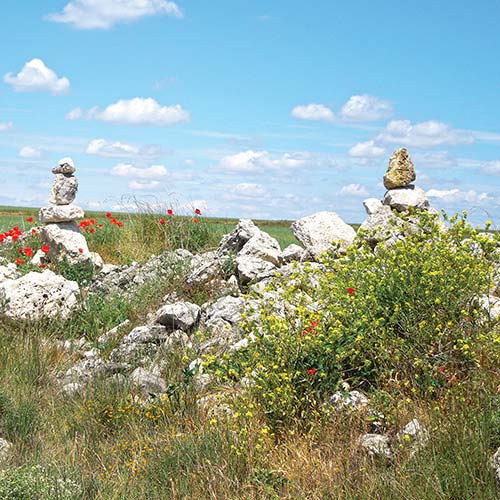
Pedras Sagradas (sacred stones) on the trail just past Rabé de las Calzadas
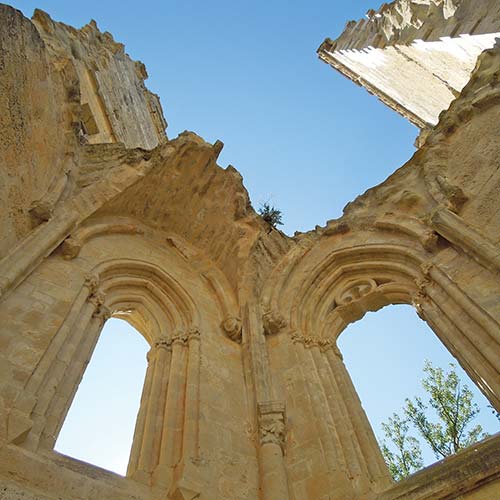
partially standing walls in the ruins of San Anton’s medieval monastery
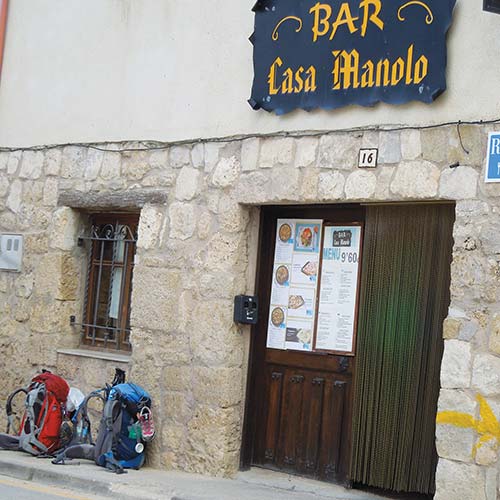
Bar Casa Manolo in Hornillos del Camino
Before fully passing under this arch to continue on the Camino, follow the wall to your left to see what else survives of the ruins. Standing in the middle of the monastery, with its collapsed ceiling, decaying Gothic walls, and grass growing across the monastic floor, is a hauntingly beautiful experience. Look at the windows to find the one showing the symbol of the Antonines, the form of a Tau cross: a cross with three arms, somewhere between a T and a Y. Medieval brothers baked the Tau cross into loaves of bread in order to heal pilgrims of illnesses—especially Saint Anthony’s Fire. The Tau was (and by some, still is) considered an esoteric symbol through which Saint Anthony comes to one’s aid and administers cures. In recent Camino lore, the Tao cross is also associated with the Templars, who like the Antonines were on the Camino to protect and serve the pilgrims.
You can still sleep in the ruins, in a simple small shelter built against the side of one of the standing moanstery walls, and benefit from the legacy of kindness and a simple but good meal at the donation-based Albergue San Antón (Open Oct.-Apr.; 14 beds). The sleeping area and toilets are very clean. There is water but no hot water and no electricity. Dinner is by candlelight.
The approach to the hilltop town of Castrojeriz (pop. 552) is beautiful: the Iglesia del Manzano appears on the horizon, tucked into the protective foot of the castle hill, and grows slowly larger as you approach. The town is small and seemingly sleepy but full service, lively, warm, and with a vibrant community that comes to life after the siesta hour. Underneath the entire town are interconnecting tunnels that hide wine cellars. They are privately owned, but you can get a glimpse of these if you stay in the Posada Emebed, or just ask anywhere you alight if you can get a glimpse of the subterranean world.
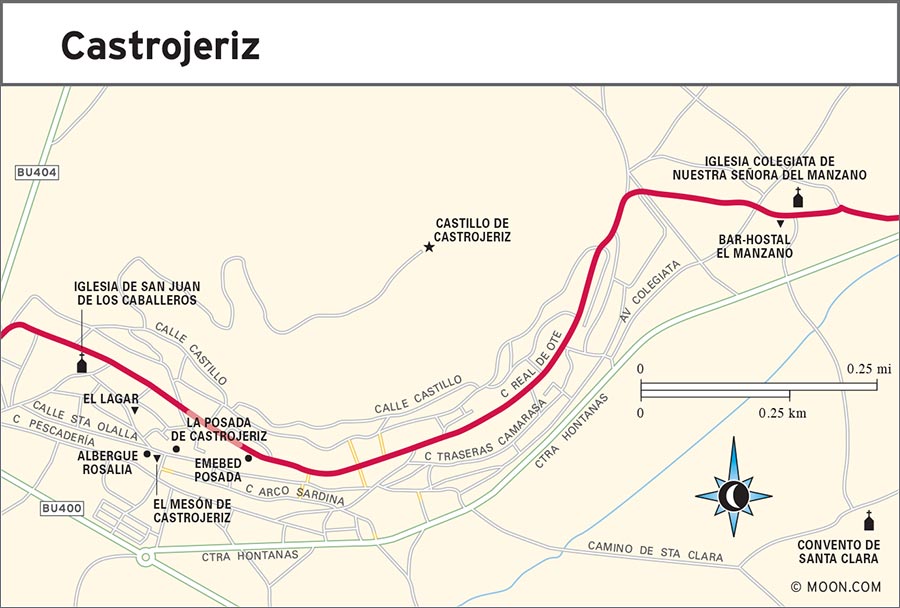
Castrojeriz was an Iron Age Celtiberian site that was later dominated by Romans. In the early Middle Ages, Visigoths took this hill, and soon after them, Iberian Muslims and Christians alternated control over the town many times, until it fell permanently into the hands of the latter. Castrojeriz was incorporated into the Kingdom of Castile and León in 974 and was an important commercial and pilgrim town. At one point it had seven pilgrim hospitals and five churches. The Jewish population here was highly valued and protected, and some vestiges of their lives here remain, especially if you stop for a drink or a meal in El Lagar, a bar and restaurant set over what most likely was once the synagogue.
The Camino passes into the center of Castrojeriz, built on the lower half of the hill’s slope, after passing the Iglesia del Manzano on the path’s right, and all the while the castle on the hilltop far above, towering protectively over the town, also stands on your right.
The Iglesia de Nuestra Señora del Manzano, Our Lady of the apple tree, stands on the site where Mary miraculously appeared to Saint James, who was passing through on horseback. When Saint James neared an apple tree in the orchard that grew here, he saw Mary, and his horse left hoof prints in stone marking the spot where he saw the image. Local lore says that rock is still there, on the south-side entrance to the church.
This is the Virgin whose numerous miracles King Alfonso X (1221-1284) of Castile and León celebrated in his sacred songs, the Cantigas de Santa María. Out of a total of some 427 songs, five of them were dedicated to the miracles of this Mary, who especially looked out for stonemasons. Among her miracles, she’s credited with saving several masons from falls that would have been fatal without her intervention.
The church foundations reach back to the 11th and 12th centuries, though the reconstructed vaults date to the 16th to 18th centuries. The image of Alfonso X’s miraculous Madonna, the 13th-century polychrome-painted stone statue, stands in the heart of the altar, an interesting depiction of Mary holding Jesus in a complete profile view; Mary herself appears as you might see classical images of the Greek earth goddess, Demeter.
This castle’s medieval foundations carry aspects of the town’s earlier occupants: the Visigoths built a castle, here, too, and incorporated aspects of the earlier Roman fortress into it (and Romans doubtlessly used aspects of the Celtiberian castro). The builders of the medieval fortification used aspects of both Roman and Visigothic foundations.
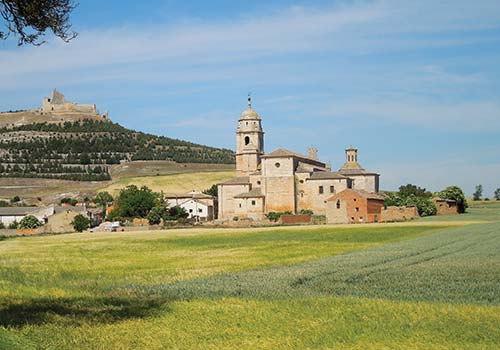
Castrojeriz’s Igelsia del Manzano, village, and protective castle hill
The medieval castle actually survived intact until 1755, when it crumbled into ruins during an earthquake that more famously destroyed Lisbon. Today, about one-third of the heavily walled, fortified castle survives, most of it having crumbled into poetic heaps except for one central wall that stands out straight into the sky.
If you want to understand the surrounding landscape’s topography, and enjoy exploring castle ruins, make the climb to the top of the hill and enjoy its view over the meseta. Both Iberian Christians and Muslims controlled the territory from this hill, on and off in the early Middle Ages.
The heavily fortified, largely Gothic, 13th-century Iglesia de San Juan (Calle Cordón, 22; 947-377-011) has, among its sacred symbols, a beautiful and unusual window in the shape of a five-pointed star. The star represents the five wounds of Christ; in medieval sacred geometry, especially for stonemasons and builders, it was the ancient Pythagorean sign of wholeness and divine perfection. In the ancient world, the five-pointed star represented Venus.
This church was originally a Romanesque building, and these foundations define the structure. It was later reformed with Gothic, Mudéjar, and Baroque elements. Ornate Mudéjar woodwork and painting forms the ceiling of the beautifully preserved cloister. In the cloister garden, notice the solar disk tombstones, which are common across Basque Country and Navarra and signify the blending of earlier pagan ideas with later Christian ones. The tombstones are round and engraved with images of intersecting arms that suggest both a radiating sun and an equal-armed cross. In pagan religion, the sun was considered the supreme life-giving and life-regenerating power, an association that translated smoothly to the image and concept of the cross and its representation of Jesus as the bringer of light and rebirth.
On the southeast outskirts of town are the restored convent ruins of Convento de Santa Clara (Camino de Santa Clara; 947-377-011; www.castrojeriz.com; 9am-7pm), with a lovely Gothic monastery church and walled-in compound surrounding it, containing resident and garden spaces. Alfonso X founded this convent in the 13th century, though builders constructed the current church in the 14th century and it was massively restored in the 18th century.
Once a Franciscan monastery, today the convent is run by Clarist nuns and thus is called Santa Clara. They make their living providing large-scale laundry service for businesses, and selling special pastries. (Try their puños de San Francisco, Saint Francis’s Cuffs, a spongy, cuff-shaped vanilla cake roll filled with rich cream, which you can buy directly from them at a the convent.) Daily mass is at 8:30pm in the convent church; the hours may be earlier in winter. Additionally, Lauds is at 8am (7:50 on Sundays and holidays); the Eucharist at 8:30am; Rosary Benediction at 5pm; and Vespers at 8:20pm (7:30 on Sundays and holidays).
Castrojeriz has some vibrant festivals that all involve festive processions, traditional attire, song, dance, and music. Fiesta de San Juan—Saint John’s Festival—occurs every June 24, celebrating both the summer solstice and Saint John the Baptist’s feast day; the Fiesta de Ajo—Garlic Festival—happens in mid-July, and the Fiesta de Sejo, the town’s sacred celebration of their patroness, Nuestra Señora del Manzano, is on the second Sunday in September, with processions and celebrations of the town’s folk traditions in music, dance, and food.
Like so many towns across Spain, at siesta hour Castrojeriz can feel like a ghost town, then suddenly explodes into life and activity as people leave their homes, meet friends in cafés, do afternoon and evening shopping, go to church, stroll about, and stop to gossip with neighbors. During this time, late afternoon into evening, the small squares and narrow streets hum with activity, and locals will make you feel a welcome part of it.
On entering town, break for a drink, a snack, or a meal (really good pizza is the main option, as well as the ubiquitous tortilla, Spanish omelet) at the inviting Bar-Hostal Manzano (Avenida Virgen del Manzano, 1; 620-782-768) right beside the Iglesia del Manzano. You can also check in for the night (double rooms with bath, €35) for a basic, clean, and peaceful rest. The owners sustain a remarkable sense of hospitality as thousands of tired pilgrims walk past on their way to Castrojeriz’s center, another few hundred meters ahead.
El Lagar (Calle Cordón, 16; 947-377-441) is a great tapas bar and restaurant for home-cooked meals, but it also was once the likely location of Castrojeriz’s synagogue. El Lagar, which means “the wine press,” is named after the wine press that once operated here and is still located on the premises.
El Mesón de Castrojeriz (Calle Cordón, 1; 947-378-610), the bar and restaurant connected to La Posada hotel, offers a good dinner menu (including a €10 menú del peregrino) featuring traditional Castilian cuisine from this region, such as cecina (dry cured beef), cocido (a pot au feu-style stew with meats, garbanzos, cabbage and other vegetables), various lamb dishes, and rice pudding.
Among the town’s seven albergues, the super-clean and charming Albergue Rosalia (Calle Cordon, 2; 947-373-714; open Mar.-Oct.; four rooms on two floors; 32 beds; €10) is a top pick and wins points for offering single, generous-sized beds—not bunks—arrayed in several small dormitories with rustic low timbered roofs, stucco whitewashed walls and sleek wooden floors. An honor system in the wonderful country kitchen allows pilgrims to cook at their leisure and pay for stocked items that they use, such as eggs, coffee, and pasta.
Of the five hotels in Castrojeriz, the centrally located Posada Emebed (Plaza Mayor, 5; 947-377-268; www.emebedposada.com; 10 rooms, each very different; €50-70) most feels like an elegant medieval manor (though it dates to the 19th century) in the quality of the furnishings and the stately stone walls, while possessing all the modern comforts: large rooms, comfortable beds with plush linens, private terraces with café tables, and a great view across the meseta. Additional services include massage therapy (arranged in advance) and bikes for exploring the surrounding area. If you stay here, ask the English-speaking owners to show you the underground wine cellars.
La Posada de Castrojeriz (Landelino Tardajos, 5; 947-378-610; info@laposadadecastrojeriz.es; €45) is a bit more basic, but rooms are still spacious and elegant. A nice interior courtyard patio has a good library and is an enjoyable space in which to relax.
One of the most beautiful vistas of the meseta is 3.5 kilometers (2.2 miles) after leaving Castrojeriz. A steep climb leads up the slope of the high ridge, Alto de Mostelares, (900-meters/2,953 feet). You are well rewarded for the hard effort to get here with limitless views of the yellow and green wheat fields of the meseta looking like a billowing patchwork quilt. Pilgrims have built stone mounds on this hilltop that add to the beauty. Be careful on the descent: The path is at a steep angle and is paved, making it easier to slip. High winds also gust on this hilltop and across the vast wheat fields you are hiking toward. At the end of the slope where the trail levels out again you will spy another reward, the refreshing Rio Pisuerga with the Ermita de San Nicolás settled along its eastern bank.
There is a special feng shui to the surviving vestige of this 12th-century hospice and hermitage, Ermita de San Nicolás, now a refuge. The single rectangular stone building stands at the base of a dale, with a sweeping horizon through wheat fields beyond. The Rio Pisuerga flows nearby, crossed by the lovely Puente de Itero, a bridge with 11 arches dating to Alfonso VI’s rule in the 11th century.
Before crossing the bridge, stop to visit the inside of the hermitage and consider staying at S Ermita de San Nicolás (947-377-359; open mid-May through September; 12 beds; €5). It is well run and serene, if rustic. Originally run by Benedictine monks, today it is run by Italian hospitaleros, who offer excellent hospitality and serve a communal meal by candlelight (only the bathroom has electricity). The river burbling nearby completes the calm atmosphere. At night, this a great place to view the Milky Way.
A little over 1 kilometer (0.6 miles) after crossing the bridge next to the hermitage, you’ll pass a 16th-century church as you enter into the village of Itero de la Vega (Km 438), an oasis in the middle of vast swaths of wheat fields. The village’s Hostal Puente Fitero (979-151-822; eight rooms; €30-40) is also an albergue (22 beds; €6) bar, restaurant (with menú del peregrino for €10), and little food shop. The whole establishment is well run and impeccable.
Before you leave, stock up on water and food if you need it; the next stretch is 8.5 kilometers (5.3 miles) without support services until you reach Boadilla del Camino. Three kilometers (1.9 miles) after Itero de la Vega, you’ll cross the Canal de Pisuerga, a manmade canal built to irrigate farmland in this wheat-growing territory, which defines the 5 kilometers (3.1 miles) to Boadilla.
In the center of Boadilla, you pass the farming village’s most distinctive feature: the Rollo de Boadilla, a towering and intricately carved Gothic cross covered in scallop shells. The 15th-century cross has a macabre history attached to its artistry: This was a post of justice, and people found guilty of serious crimes were hanged here. Its tradition comes from the era of Enrique IV (1425-1474), who granted Boadilla self-governance from outside powers. Near the cross is the 15th- and 16th-century church of Santa María, a solid structure that was restored and reformed many times into the 18th century.
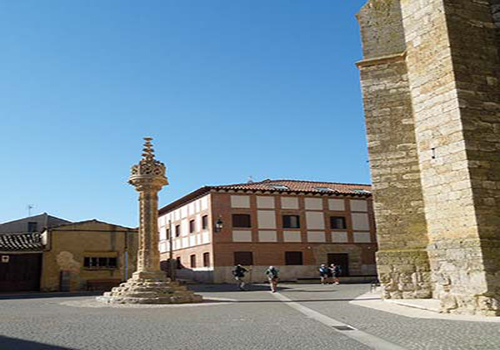
Boadilla del Camino’s medieval post of justice, the Rollo de Boadilla
Off the same square as the church, Albergue En El Camino (Plaza el Rollo; 979-810-284; www.boadilladelcamino.com; Mar.-Oct.) is a favorite pause, in part for its large garden and pool, but mostly for the easy-going warmth of its hospitaleros, who also offer great food and drink. They offer 70 beds in four large dorm rooms (€8/bed), and an evening meal for €10; breakfast is €3.
Approximately 1 kilometer (0.6 miles) after Boadilla del Camino, the Camino meets up with and runs parallel to the left of the Canal de Castilla, which was built for irrigation in the 17th and 18th centuries. It is rife with frog, toad, and bird life, as well as wild yellow irises, four types of lizards, and water snakes. From here, another 4.8 kilometers (3 miles) remain to Frómista.
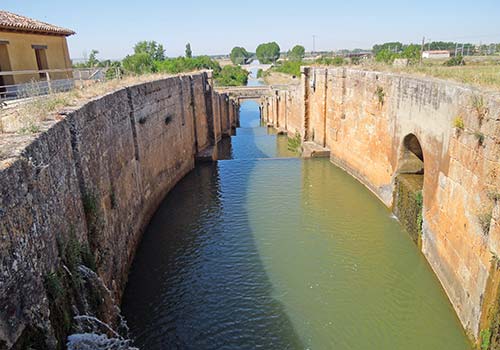
lock of the Canal de Castilla just before Frómista
To enter Frómista (pop. 790), the Camino crosses a bridge over the Canal de Castilla at the point of an elaborate damming gate that controls the flow of water. You then enter on the main road into town, passing the train station on your left.
Sunflowers, wheat, and barley cover the fields surrounding Frómista, making the horizon a gorgeous melding of bright blue sky and golden undulating earth. In spring, that horizon transforms into a pale green speckled with red poppies. This territory has long been the heart of Spain’s breadbasket. Celts and Celtiberians cultivated the land here, and Romans called this town frumentum (“cereal” in Latin). By the 11th century, Frómista was an important religious and market center on the Camino. It also was home to an ancient Jewish community that continued to thrive into the 14th century. In 1492, when the Spanish monarchs Isabel and Ferdinand forced conversion or expulsion upon its Jewish and Muslim communities, the economy and agriculture diminished with their decline, here as well as across significant parts of the country.
Frómista today is still about wheat and bread—this is its main industry—but also about cheese, which is celebrated at an annual festival in July. If you can’t be here for the festival, be sure to visit the local art exhibit space, café, and sale venue for local cheeses, La Venta de Boffard.
For a town of nearly 800, Frómista feels more like 200, but you’ll nevertheless find several nice places to eat and sleep. The outdoor cafés surrounding the church of San Martín probably offer the best atmosphere, but don’t overlook the more intimate square behind the Iglesia de San Pedro, also with several good cafés and inns.
Frómista has three churches: the Iglesia de San Pedro, fortified, sturdy, largely unadorned but with elegant vaults, from the 13th century; the largely 16th-century Iglesia de Santa María del Castillo; and the reason why people visit Frómista, the Iglesia de San Martín, one of the jewels of medieval Iberia, built in the 11th century. San Martín is worth all the time you can offer it, both to take in all the stone images engraved in the corbels and capitals inside and out, and also to enjoy the visceral feeling of being in a sacred space built to perfect proportions for the human form.
The Iglesia de San Martín de Tours (Plaza San Martín, 3; 979-810-144; Apr.-Sept., daily, 9:30am-2pm and 4:30-8pm; €1, free on Wed.), was built in AD 1066 and once belonged to an adjoining Benedictine monastery that no longer stands. It is considered the purest French Romanesque church in Spain, and in many ways, it is a prototype for understanding the proportions, harmony, and richly expressive sculpture of the Romanesque style in France as well. Step inside to take in the pleasing pale yellow domed ceiling sweeping overhead, or the many carved capitals recounting Biblical, historical, moral, and humorous tales. A personal favorite, on the second pillar from the back end of the church, on the left in the central nave, depicts the vain raven with a loaf of bread in his beak, and the clever fox who wanted to steal it. The fox praised the raven’s magnificence, and when the raven opened his mouth to respond, the loaf fell and the fox took off with it. The imagery culminates in the statue of Jesus at the altar, and, to his right, the compelling dark-toned wooden sculpture of La Virgen de la Acogida, the Virgin of the host. Another aspect of the intimate artistry is how the proportions and shape create perfect acoustics. If you sing here, the resonating sound will wash over you and transport you to another level of sacred experience.
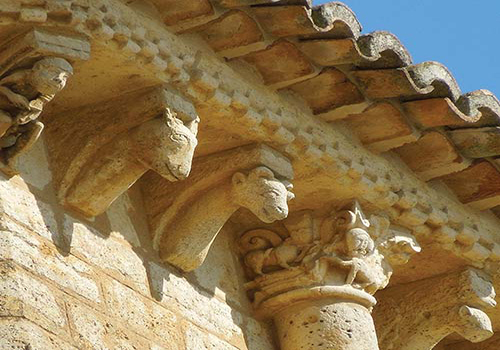
sculptures on Frómista’s Iglesia de San Martín
Once, risqué corbels—a veritable Kama Sutra of the Middle Ages—adorned the church’s exterior, but many of these were replaced with sedate floral and geometric patterns when the church was restored between 1896 and 1904. (Ironically, those sexually explicit sculptures reflected not inhibition, but an earth-bound and honest view of humanity in 11th-century Europe. In fact, at the time, it was the norm in Europe to show that chaotic world on the outside of churches, and then invite the nonliterate populace to step inside the church, where the chaos and wildness of life is controlled and tamed.)
A few of the saucy corbels do remain, along with many expressive and idiosyncratic characters that depict local folklore and stories. Look especially for the contemplative sage wearing a turban, the woman who has just given birth, the giant baring his sharp teeth, and the playful animals with charming expressions. There are also three sculptures of waterfowl (ducks, geese, and swans), considered symbols of fidelity and also guides and gatekeepers of the heavens. They also may have an association with the medieval-to-early modern-game, the Game of the Goose, where they also act as guides and guardians of pilgrims on the Camino.
In the third week of July is the Feria del Queso (979-810-001; administracion@Frómista.es), the cheese fair where you can taste the artisanal cheeses (largely sheep’s milk) and meats (including chorizos and morcillas) produced in the region.
To purchase gourmet goods for a picnic before heading back on the trail, especially the sheep’s milk cheese from Frómista, queso de oveja Boffard, stop at La Venta de Boffard, a shop as well as a café, bar, restaurant, art gallery, and garden.
La Venta de Boffard (Plaza San Martín, 8; 979-810-012; www.laventafromista.com; €10-12) is an art exhibit space, music venue, and a food-lover’s paradise, combining a love for Palencia’s foods (cheese, charcuterie, homegrown greens) with art and ethnography. Run by two English-speaking sisters from Palencian and Basque backgrounds, they welcome everyone warmly and hold pilgrims as special guests. In this spirit, they prepare a gourmet menú de peregrino as well as an array of other offerings, such as savory toasts with bellota (acorn-fed cured ham), Boffard cheese, and smoked salmon, as well as desserts such as white chocolate flan. The Iglesia de San Martin, just outside on the square, adds to the artsy atmosphere.
El Apostal (Avenida Ejército Español, 5; 979-033-209; www.hostalelapostal.com; €10) is frequented as much by locals as by pilgrims. They offer a straightforward and fresh menú del dia that offers three courses with many choices, including vibrant fresh salads, grilled fish, and stuffed red peppers, with just-plucked Persian melon for dessert.
S Restaurante Doña Mayor (Calle Francesa, 31; 979-810-588; www.hoteldonamayor.com; €18) is more than a hotel; it’s also a great restaurant and bar. Departing from the typical menu, the Doña Mayor offers an a la carte splurge with dishes such as lemon- and rosemary-grilled salmon, a vegetarian sauté of local vegetables with chickpeas and artichoke mayonnaise, and two varieties of lasagna (spinach or meat). Desserts include blackberry cheesecake, brownies, and lemon-blueberry sponge cake, served on slate planks. In good weather, you can choose to dine in the private garden.
Frómista has a wide array of accommodation among its four albergues and almost a dozen pensions, hostales, and hotels. Nothing distinguishes the albergues, but the range of other accommodation might entice you to splurge for private digs; if you share a room with one or two other pilgrims, the price can be quite sweet.
Named after the 11th-century patroness of the Iglesia de San Martín, the Hotel Doña Mayor (Calle Francesa 31; 979-810-588; www.hoteldonamayor.com; 12 rooms; €70-100, which typically includes breakfast) is a modern building in the old center of town with an excellent bar and restaurant. All spaces—guest rooms and dining—are contemporary designs with earthy and appealing woodwork along the walls and floors. Large floor-to-ceiling windows let in copious light. They offer a large buffet breakfast with gluten-free options (€9). Proprietors speak English.
Hostal El Apostal (Avenida Ejército Español, 5; 979-033-209; www.hostalelapostal.com; €30/45/60 with breakfast) is not only a great restaurant but also a lovely inn on a quiet square next to Iglesia de San Pedro. Rooms are a mix of modern and cozy. Proprietors speak English.
Across the street from Iglesia San Pedro, S Hostal San Pedro (Avenida Ejército Español, 8; 979-810-016; www.hostalsanpedrofromista.com; €30-55) feels like home. The welcoming and engaging proprietor, July (pronounced who-lee), has designed her boutique-like hostal with great artistic flair. Rooms are painted with saturated, earthy colors, and the floors are sleek gray tiles. Bathrooms are spotless. The whole place is decorated with restored antiques from 19th- and 20th-century Castile. July offers a good buffet breakfast (€4.50) in the communal dining room.
Three trains daily depart Madrid, with a change in Valladolid, for Frómista (2.5-4.5 hours; €27-40).
You will walk on a dirt path that runs parallel to the right side of the P-980 from Frómista to Población de Campos (3.4 km/2.1 mi).
Just a few hundred meters before arriving in Poblacion de Campos (pop. 137), a village founded in the 11th century, you pass the lyrical hermitage, Ermita de San Miguel, a small chapel with transitional Romanesque corbels and Gothic doorway from the 13th century. The villagers of Poblacion de Campos have arrayed picnic tables here for pilgrims to enjoy a rest in the shade of the poplar trees, an oasis in the meseta.
The village has two other churches. The 16th-century Iglesia de Santa María la Magdalena is on the village’s highest hill. Just below it is a hermitage set almost below ground—or, more accurately, the ground level has risen from later building over older settlements—making for a slight climb below street level to enter into the earthy and acoustically rich 13th-century Ermita de la Virgen del Socorro.
The rural hotel, Amanecer en Campos (Calle Fuente Nueva, 5; 979-811-099; www.hotelamanecerencampos.com) offers lunches and dinners based on home-cooked dishes passed down for generations, including paella, Castilian soups, dishes from locally harvested vegetables, and homemade desserts. They also have 14 country-inn-style rooms (floral bedspreads, colorful walls with floral paintings) for €30-45, all with private baths; breakfast is €3.
The Albergue La Finca (on the P-980 across the road from the Ermita de San Miguel; 979-067-028 and 620-785-999; www.alberguelafinca.es; 20 beds; €10) is a stone, brick, and terracotta farmhouse with wonderful modern interiors—wide-planked wooden floors, modern bathrooms, a large country-style dining room, and an open lounge and kitchen with copious natural sunlight. A garden with pool and Japanese bridge are a calm space to rest. Beds (singles, not bunk beds) are in inset wall nooks with curtains, offering privacy. The restaurant and bar serves a menú del peregrino (€10) or an a la carte menu, specializing in regional dishes and Castilian wines.
Población’s more basic municipal albergue (Calle Escuelas, 17; 979-811-099; €5) has 18 beds in one dorm room. Both albergues are open all year. The town also has three bars for meals, snacks, and drinks, and a shop for provisions.
Soon after Población de Campos, the Camino splits. Both paths lead to Villarmentero de Campos. The path heading to the right eventually becomes a riverside path and adds 0.9 kilometers (0.6 miles) to the walk. The other continues straight on the P-980 road that you have been on since Frómista.
The river path is more appealing and passes along the life-giving waters of the Río Ucieza, where you’ll see stands of poplar trees and rich bird life, including European robins, canary-like serins, green woodpeckers, owls, hawks, and falcons.
The P-980 leads directly to Villarmentero de Campos (pop. 23). If you took the riverside path, the town is connected by a few-hundred-meter-long country road from the river—look for the distinctive white teepees in a field that identify the village. The 16th-century village church, Iglesia de San Martín, is interesting for its Mudéjar—Islamic-style—ceiling. (To go inside, ask a local if someone can unlock it.)
La Casona de Doña Petra (Calle Ramón y Cajal, 14; 979-065-978; www.lacasonadepetra.com; €35-55) with 12 private rooms, offering meals (€15) and breakfast (€5), was once a pilgrim hospice that operated until the late 17th century. Interestingly, when the present (English-speaking) owners restored the place, they discovered a hidden box containing an ancient deed in Hebrew that identified a Jewish resident as the owner.
The Albergue Almanecer (Calle Jose Antonio, 2; 629-178-543) offers 18 beds, three teepees (the very ones you saw when you approached the village), and three outdoor hammocks. For outdoor sleeping and sharing the grounds with wandering farm animals (donkeys, chicken, geese), the hammocks (€3) and teepees (€3; the ground is hard) give a novel twist to pilgrim lodging. Inside are comfortable bunkbeds (€6). The couple who runs Almanecer is celebrated for their homemade communal meals, prepared with care and passion. The dining area feels like a country farmhouse, with a wonderful long wooden table.
Both paths—the P-980, or the dirt road back to the river path—lead next to Villalcazar de Sirga. I recommend that you continue on the riverside path, where just before Villalcazar you’ll arrive at Ermita de la Virgen del Río after crossing a bridge over the Ucieza river. Once a 12th-century Romanesque church, now largely from the 18th century, this hermitage remains an active sacred center for the people of Villalcazar de Sirga. This Lady of the River has a story similar to that of Logroño’s Virgen del Ebro, who was found floating in the Ebro river: Locals found the Virgen del Río’s icon floating up the Río Ucieza after a flood, and this shrine marks the spot where she came ashore. The brotherhood of the Virgen del Río, formed in 1650, carries on annual celebrations in her honor on the Monday after Pentecost Sunday (seven Sundays after Easter). The hermitage is open only on feast days, but has a generous covered porch where you can rest as well as some picnic tables on its grounds.
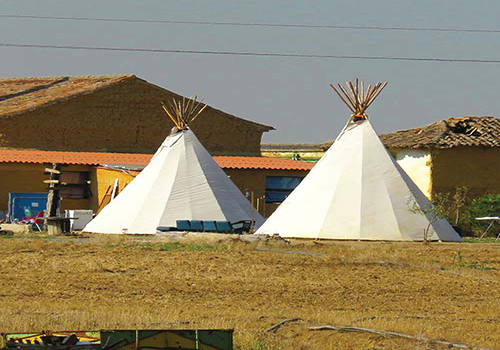
teepees for peregrinos at the Albergue Amanecer in Villarmentero de Campos
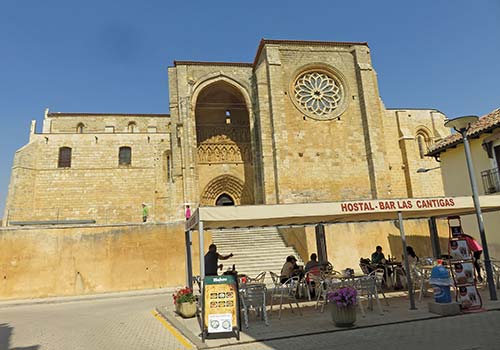
Iglesia de Santa María la Blanca in Villalcázar de Sirga
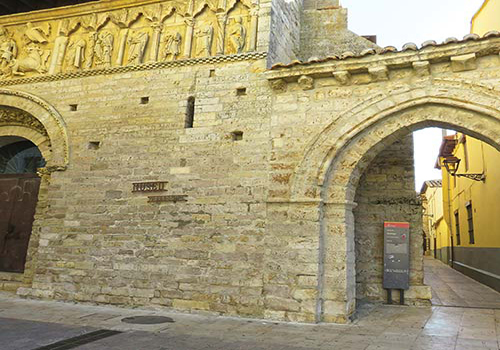
Iglesia de Santiago in Carrión de los Condes
Just before entering Villalcazar de Sirga (approximately 30 meters/100 feet), if you have been walking the river side path, is Palomar del Camino (Kilometer 10 on the P-981; 653-916-600; www.palomardelcamino.com; menú del peregrino €10, a la carte €15), a good place for food and drink on the left side of the Camino and located in the round, white-stucco 19th-century dovecote (palomar) with shady terrace seating. A nice alternative to the lusty meats, stews, and casseroles of Castilian cuisine (which you will find in the restaurants in Villalcazar’s central Plaza Mayor), it serves up nourishing and tasty lunches such as fresh salads and empanadas. Proprietors speak English.
As you enter the small village of Villalcázar (pop. 172), notice the mounds and Hobbit-like holes with doors in the hillsides. These bodegas are where local families make and store their wine, as well as their harvest, cheeses, and cured meats. They are also social gathering places; in summer they can be a surprisingly cool.
Villacázar revolves around its celebrated church, Iglesia de Santa María la Blanca, and the Madonna, La Blanca, that it houses. In the 13th century, King Alfonso X of Castile and León wrote, or commissioned, twelve of his sacred songs, Cantigas, about La Blanca’s miracles. In fact, La Virgen Blanca performed so many stunning miracles—from restoring a blind man’s sight to lifting a 24-pound weight a sinner was sentenced to carry—that Villalcázar became an important pilgrimage destination, and the Camino was actually redicted in the 13th century to pass through it.
It is possible that the Templar Knights used Villalcázar as a base from which to protect and serve pilgrims on the Camino. However, it seems more likely that this service was fulfilled by another knightly order, the Order of Santiago, though tradition and lore still refer to this as a Templar town. The Templar residence, the cloister, the towers, walls, gates, and pilgrim hospices were all largely destroyed by the 1755 earthquake or soon crumbled thereafter. That the church is still here is something. What remains feels epic: you feel the church’s towering height as you walk into town.
Built in the late 12th and early 13th centuries, the transitioning Romanesque-to-Gothic Church of Santa María la Blanca (Plaza Mayor, s/n; 979-880-854) is like a fortress, and probably was used as one in times of duress. The high-porched entrance has Christ in Majesty and the Tetramorphs on the upper sculptured line; below them is Santa María la Blanca.
Inside, the church is unusual in that it has three naves and two crossings. You’ll find the sculpture of the miraculous Mary of Alfonso X’s Cantigas in the center of the altar’s retable. This sculpture is also distinct in that it is carved of stone—like that of Castrojeriz’s Virgen del Manzano—and not wood, the more common medium of revered Marian icons along the Camino.
You’ll easily locate the chapel dedicated to Santiago; it is in the end of the transept that includes the church’s beautiful and unusual rose window. With 14 petals, rather than the more typical 6, 8 or 12, this window is also aligned to let in the midday sun.
The posted visiting hours are May-Oct.15 10:30am-2pm and 4:30-7pm; Oct.16-Apr. Mon.-Fri. by arrangement, Sat.-Sun. and holidays 12-2pm and 5-6:30pm; visits are free unless you arrange a guided tour (€1). Despite these posted hours, the church, especially in the early autumn, is typically open in the mornings, but the afternoons are less certain.
S Mesón de los Templarios (Plaza Mayor; 979-888-022; www.mesonlostemplarios.com), next to the church, and S Meson de Villasirga (Plaza Mayor; 979-888-022; www.mesonvillasirga.com) are run by the same proprietor, Pablo Payo. He opened the former in 1984 and the latter in 1965. Both are on the Plaza Mayor, kitty-corner from each other. Both serve classic Castilian food, medieval-banquet style, including roasted meats on bread plates meant to be eaten, large casseroles, and special pastries, including the anisseed-laced ones you may have smelled on entering the village. These are among the Camino’s most traditional (and sought out) restaurants. Payo opened the original, Mesón de Villasirga, to better serve pilgrims’ culinary needs, which it delivers in a large communal hall. The Mesón de los Templarios is also intended for pilgrims and other visitors, but is a bit more formal and transports you more to the Middle Ages. People habitually drive from Burgos and Madrid just to eat at both places, where a meal typically can run €15-25. If one place is fully booked or closed, be sure to try the other.
S Confitería La Perla Alcazareña (Calle El Ángel, 4; 979-888-020; www.pastelvillasirga.com), family operated for four generations (since 1870), lures locals and visitors alike with the butter-and-anise aroma that wafts from its ovens down all the streets of this little village. The bakery’s creations include traditional Castilian almond cookies, almendrados, and little almond cakes, amarguillos. They also supply the dessert served at Meson de los Templarios and Meson de Villasirga. You’ll find the bakery on the Camino as it is about to depart the village, on the right side.
Bar Hostal Las Cantigas (Calle Doctor Durango Solomon, 2; 979-888-027; www.hostallascantigas.es; €30 for a single, €40 for a double; wifi available) gets its name from its location, across the square from the celebrated church of Santa María La Blanca, for whom Alfonso X composed several cantigas. It merits a cantiga for its calm, clean, and welcoming atmosphere and excellent bar frequented by locals as well as pilgrims. They serve breakfast (€3.50) and a good, basic, and fresh menú del peregrino (€9.50) for dinner.
Casas Rurales Don Camino (Calle Real, 1; 979-888-163 and 620-399-040; www.casa-aurea.es) offers three rural hotels—Casa Áurea, Casa Federico, and Casa La Era—for nightly rent that come complete as apartments (€120-180/night), and, at the other end of the spectrum but also impeccable, the Albergue Don Camino (€7/bed). All options offer a private courtyard garden and a wonderful bar and restaurant serving specialties “taught to us by our grandmother, Abeula Áurea.”
Set on a bluff, sprinkled with compelling medieval churches, and populated with warm, sincere people, Carrión de los Condes (pop. 2,087) is a delightful place to visit. But the true highlight of this town is the singing nuns of the parish and albergue of Santa María. Many pilgrims report this as one of the apex experiences of their pilgrimage.
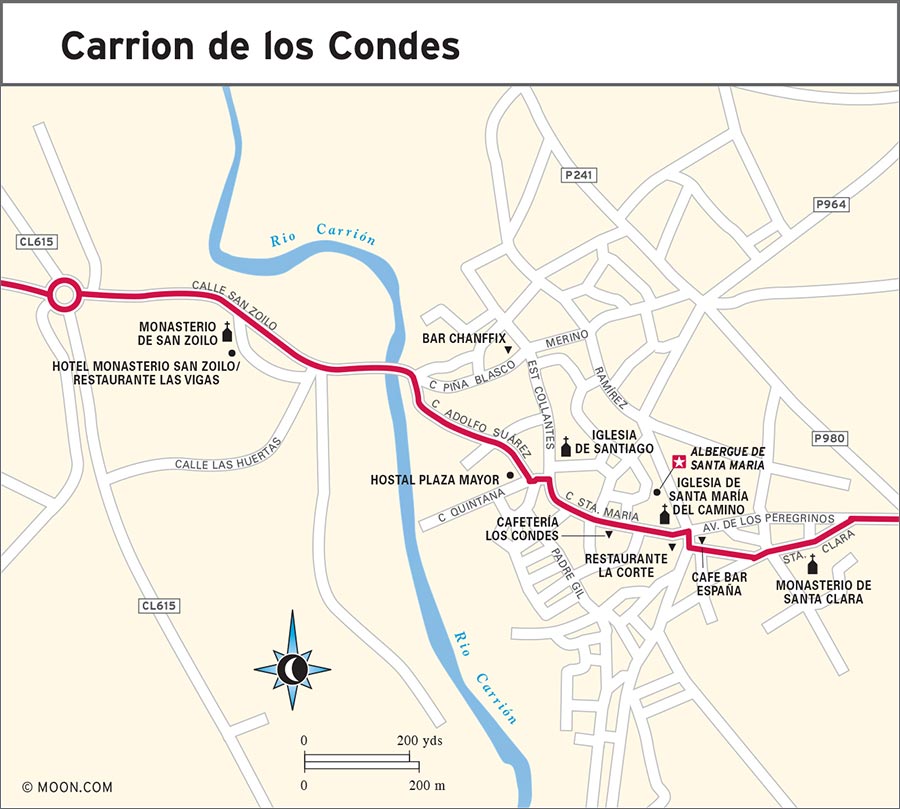
The town was first a Roman settlement, picked for the bluff with the river below and a terrific view of the world beyond. Visigoths next settled here, and in AD 713 North Africans conquered the town. By the 11th century, the town had a population of nearly 10,000 and was massively wealthy and hugely influential. Its wealth derived from large and diverse agricultural harvests and from the movement of people that the Camino opened. As with Burgos, Castrojeriz, and Fromísta, Carrión had a large Jewish community.
Carrión has a rocking weekly market around the Plaza de Santa María every Thursday morning, with food and produce vendors setting up alongside merchants selling clothing, shoes, household goods, and textiles. If you need to replace a piece of gear or buy a fruit knife or a corkscrew, this is the place to do it.
In its medieval height, during the 11th and 12th centuries, Carrión had thirteen parishes and a vast network of pilgrim support structures that could house up to 10,000 people. Today a few survive, the most interesting being the churches of Santa María and of Santiago, San Zoilo’s monastery, and if you are interested in Saint Francis of Assisi, the monastery of Santa Clara.
Saint Francis of Assisi slept in the Monasterio de Santa Clara (Calle Santa Clara 1) in 1214 when he made his pilgrimage to Santiago de Compostela. The cool part is that you can too. The present convent is mostly from the 17th century. Access to the monastery is restricted, but its albergue has a wonderful enclosed and porticoed courtyard reached as soon as you pass through the entry gate. The spaces designated for housing pilgrims are well kept. The convent has a small museum of sacred art, Museo de Santa Clara (Calle Santa Clara, 12; 979-880-134; www.carriondeloscondes.org; daily 11am-1:30pm and 4:30-9:30; €2), which also showcases the site’s Franciscan history. Little of the 13th-century founding monastery survives.
From the 12th century, a compelling aspect of the Iglesia de Santa María (Plaza Santa María, 1; 979-880-072; www.carriondeloscondes.org; open daily, Oct.-Mar., 11am-1:30pm and 5-7pm, Apr.-Sept., 9am-2pm and 4-9pm) is its porched entrance, adding more three-dimensionality to the overall south-facing door. The interior has a single nave, with similar transitional Romanesque-to-Gothic arches and engravings. Some of the polychrome decorative painting on the walls is still visible. The most appealing sculpture (of Mary, a lovely 12th-century depiction) is on the west entrance, facing the square where the Thursday market also sets up. You can enjoy a mass here daily at 8pm.
The surviving part of this 12th-century church, destroyed by fire in the early 19th century, is its west entrance, a great example of Castilian Romanesque. There, Christ in Majesty is surrounded by the 24 Elders of the Apocalypse. Look closely to see characters from daily life in medieval Carrión: a cobbler, a tailor, a monk with book, dancers and acrobats, a scribe, a female zither player, and a blacksmith, among others. A later Mudéjar-style bell tower is harmonious with the 12th-century façade. The Iglesia de Santiago contains the Museo del Arte Sacro (Calle de la Rúa; 979-880-072; www.carriondeloscondes.org; May-Sept. Tues.-Sun. 11am-2pm and 5-8pm, Mar.-Apr Tues.-Sun. 11am-2pm and 5-7pm; €1 guided visit), a museum of sacred art.
The Monasterio de San Zoilo (Calle San Zoilo, 23; www.carriondeloscondes.org; summers only, 10:30am-2pm and 4:30-8pm; €2) was founded in the 900s in the name of Saint John the Baptist. When the trade of relics—and their ability to draw pilgrims and funds—peaked in the 11th century, the name changed to San Zoilo after a gift of this Cordoban saint’s relics in 1047 from the Cordoban emir.
San Zoilo was under the Cluny Order then and was the second most powerful monastery in the Castile of the 11th and 12th centuries, surpassed only by Sahagún down the road. Jews, Christians, and Muslims in Carrión paid their royal taxes to the monastery instead of the king in the 13th century, amping up the financial prosperity of San Zoilo. After the 14th and 15th centuries, the monastery’s influence declined. Today, it is an important site of national patrimony and also a luxury hotel that has turned the monks’ quarters into guestrooms.
The cloisters have late Gothic arches and date to the Renaissance, built between 1537 and 1604, and are impressive for their unity of style and preservation. Seek out the older Romanesque doorway, which survives from the 11th century and was found hidden behind a wall in 1993.
Whether or not you stay here (though it is worth it to stay), the nuns who run the Albergue de Santa María (Calle del Clérigo Pastor, 6; 979-880-768) welcome pilgrims to gather in the large common room at 6:30pm, when they pull out a guitar and drums and perform sacred and folk songs with their beautiful voices, encouraging everyone to sing. They also lead the prayer service in the church next door, Iglesia de Santa María, with Vespers at 6pm, and mass and the pilgrims’ blessing at 8pm. If you stay here, they serve a cheerful communal meal at 9pm.
The Cafe Bar España (Plaza Piña Merino, 1; 979-880-047; €4-10) doubles as the town bus and taxi stand. But this also is a great informal place for a bite—whether you intend to keep walking or to wait for the bus—offering freshly made tortillas (Spanish omelets), sandwiches, good breakfasts, and all types of drinks.
Restaurante Las Vigas (Calle Obispo Souto, s/n; 979-880-050; www.sanzoilo.com/restaurante; €25-35) is an upscale choice located in the old monastery kitchen of the Monasterio de San Zoilo, today a warm wood-toned, brick and stone tavern setting. Modern interpretations of traditional dishes include grilled vegetables—verduras a la plancha—diversified with grilled leek, green asparagus, cauliflower, zucchini, brussel spouts, and carrots with piquant romesco sauce; cream of pumpkin soup with ham; the quintessential lechazo (roast baby lamb) for two (€45); and desserts such as coffee cream-filled pastry rolls with pistachio ice cream.
Restaurante La Corte (Calle Santa María, 36; 979-880-138; www.hostalrestaurantelacorte.com; €12-20), attached to the hostal of the same name, is a wonderful place to enjoy a menú del peregrino, menú del dia, or a la carte. Some signature offerings are cocido (bean and meat stew), shellfish-stuffed red peppers, and even game, such as venison.
Bar Chanffix (Calle Esteban Collantes, 17; 979-880-435; €8-12) gives a modern twist to traditional Castilian cuisine (such as blood sausage, morcilla, and scrambled eggs) while also doing all the things a good bar does: offer every kind of drink and snack along with good robust menús del peregrino, salads, tapas (shared plates with 2-3 others, which can make for a great lunch or dinner), and homemade desserts, with terrace and inside seating. Excellent wine selection and vermouth.
An upbeat and inexpensive place, the Cafetería Los Condes (Plaza Mayor s/n; 979-880-136; www.cafeterialoscondes.com) serves up large tapas (€6-14), salads and soups (€3-7), combined platters (€8-9), paella (€11), and pizza (€9) on the cheerful corner of the Plaza Mayor right where the Camino passes as it leaves town.
S Hotel Monasterio San Zoilo (Obispo Souto, s/n; 979-880-049; www.sanzoilo.com; €60-105), attached to the monastery, is the town’s upscale accommodation, in a lovely riverside setting on the western edge of town right on the Camino. It’s often a gathering place for cyclists on the Camino, with good space for bikes. It’s a splurge, and the atmosphere can be a little more touristic and formal, with less of the usual Camino camaraderie. But the rooms and location are idyllic, with views of the monastery church and cloister. There is an atmospheric brick-and-tile hotel bar, and the hotel restaurant, Las Vigas, serves traditional cuisine.
Hostal Plaza Mayor (Calle Adolfo Suarez, 1; 669-340-131; www.hostal-plaza-mayor-negocio.site; €55, but inquire: they give special prices to pilgrims) opened in 2017, a wonderfully modern place with a fun, plucky sense of color and design while holding down a classical edge. It is on a cheerful corner of the main square, right on the Camino. It has clean and quiet rooms with private baths, some with terraces.
Turning right past the church of Santa María is the S Albergue de Santa María (Calle del Clérigo Pastor, 6; 979-880-768; open Mar.-Oct.; 54 beds; €5), run by Augustinian singing nuns. It is a wonderful chance to hear and join in with sacred and folk song—the nuns play instruments as well as sing—an experience many pilgrims have claimed as one of the highlights of their entire Camino. It has a well-equipped kitchen and they offer a communal meal. The sleeping area is very clean and the bunkbeds comfortable. They serve watermelon as refreshment and send you off with blessed six-pointed stars to grace your Camino.
Monasterio de Santa Clara (Calle Santa Clara, 1; 979-880-837; Mar.-Nov.) offers 30 beds in four dormitory rooms of varying size (one only has two beds) at €5-7, with a shared bath in the albergue section of the monastery. Their Hospedería, hostel, offers nine private rooms with private baths for €25/50 for single/double. Come here not only to sleep where Saint Francis slept (in 1214), but also to enjoy a very inviting atmosphere, from the entrance at the porticoed courtyard off the street, to the common spaces, kitchen, and ultra-clean (even if in some cases small) sleeping quarters. They do their share of singing here too; if you join the 8:30am Eucharist, you’ll be treated to sacred song. Consider purchasing some of their special cupcake-like magdalenas for the road from the turnstile gate of the monastery.
The best way to find a taxi in Carrión is at the cafe Bar España (Plaza San Merino, 1; 979-880-047), which also happens to be where you can buy ALSA/Monbus bus tickets and wait for the bus, which stops out front. Two taxi services here are Taxi Mariano Hervás Morante (608-486-059) and Taxi Jesús García Melgar (979-880-918 and 639-886-824).
The next leg of the Camino is a long 16.9 kilometers (10.5 miles) to Calzadilla de la Cueza (Km 387.3, pop. 53) without support structures in between. (Most times there should be a caravan-like mobile café along this long stretch, but it can’t be guaranteed.) Get an early start, if walking in the warm seasons, to cover most of this terrain before the midday sun. Calzadilla de la Cueza does offer food and lodging, but I do not recommend staying here. Instead, refuel at the village bar if you need a rest and provisions, and then continue on to Ledigos or Terradillos de los Templarios.
Alternatively, consider a sightseeing variation: Arrange a detour via taxi from Carrión de los Condes to visit the Roman Villa of La Tejada and then ask to be dropped off in Ledigos.
The legacy of Ledigos (pop. 67), in times past as today, is to offer the weary traveler a place to stay; this village has one of the best albergues in Castile.
Inside the Iglesia de Santiago, which dates to the 13th century, you’ll find several statues of Saint James.
A woman nicknamed La Morena founded S Albergue La Morena (Calle Carretera, 3; 626-972-118; www.alberguelamerena.com; open all year); today, her granddaughter and her family carry on her work ethic in this albergue, exceptional for its hospitality. They serve a great home-cooked menú del peregrino (€10) in the restaurant and bar, or you can cook for yourself in the well-equipped kitchen. The lodging is pristine and spacious. Options here cover the spectrum, from dorm beds (€8) to private rooms with shared bath (€35) and private rooms with private bath (€50).
After a very long stretch on the flat meseta, it’s a welcoming sight to come over the rise and see the huddle of terra cotta roofs that make up the village of Terradillos (pop. 68). The manufacture of red clay tiles and bricks is associated with this area; Terradillos’s name might actually come from the word terrados (roof) and its diminutive, terradillos (little roofs).
Terradillos dates to the late Roman period, when there probably was a villa here. Templar Knights controlled Terradillos in the 13th century, though there is no evidence that it supported hospices for pilgrims. The Mudéjar-style church, Iglesia de San Pedro, is of the signature Tierra de Campos red-brick style and houses a 14th-century icon of Christ on the cross. Villagers celebrate their patron, Saint Peter, on June 29.
The village also harbors a mystery: this is the place the last Templar Knights hid the fabled hen (or goose, depending on the telling) that lay golden eggs and was a source of their wealth.
For a tiny village, Terradillos has two good albergues with good sleeping and eating options.
Just before you enter the village, along the N-120, you’ll find what looks like a vast hacienda or modern villa house with a huge yard, open terrace, and angled timber roof entry with a big Templar cross hanging from the meeting joint. This is Albergue Los Templarios (979-065-968; www.alberguelostemplarios; Mar.-Oct.), with 52 dormitory beds (€8-10) and nine private rooms (€28-38). The airy dining hall, good food, pristine sleeping quarters, and wide green space make this a great place to stop for the day. Proprietors speak English.
The Albergue Jaques de Molay (Calle de la Iglesia, 18; 979-883-679; open Feb.-Nov.; 46 beds, €8-10/bed), named after the last grand master of the Templars (who was tortured and burned at the stake in 1314), offers clean and comfortable dormitory-style beds, with good home-cooked meals, in an enclosed garden space at the other end of the village, just as the Camino is about to exit. The Templar name is a reference to the legend of the Templars’ hidden golden hen or goose, possibly still buried here in Terradillos. The true gold is the hospitality, along with the daily meditations written on the chalkboard in the garden. A recent one: “Sometimes you have to lose yourself to find yourself.”
The village also has a general store and a bar.
About midway between Terradillos and Moratinos you will pass the spot where the medieval monastery of Villaoreja once stood (Km 376.2). The monastery operated for around 700 years, caring for pilgrims and offering lodging. It is possible that earlier it also was a Roman wayside inn. The Asociación Cultural de Moratinos, the cultural association of the village coming up next, is raising funds to excavate the monastery. Meanwhile, the site is marked with a large stone engraved with its name to the left of the Camino, near a sitting area in a grove. Look closer and you’ll also see a modern spiral labyrinth in the center of the grove, a meditative walk that invites a pause.
A seemingly sleepy little village, Moratinos (pop. 58) has panache. You’ll see it right away on the main square, with the brickwork parish church, Iglesia de Santo Tomás, decked out in colorful knit-yarn creations that are strung across the church plaza and wrapped around the trees. These “yarn trees” are the project also of the Asociación Cultural de Moratinos, who wanted to add color to their village. It’s growing into an international project as other groups join the fun: A group of women from Vandergrift, Pennsylvania, sent in crocheted creations to add to the display, and at least one Canadian hospitalera is also knitting away.
Dine in a bodega, one of those cool underground wine cellars you’ve been walking past, at S Castello de Moratinos (Calle Bodegas, s/n; 979-061-467; three-course daily menu, €13). The boxy hillside entrance opens to a great bar for drinks, sandwiches (€3-5), and excellent tapas (€6-14). But you can continue deeper into the hill for a full meal in the bodega’s subterranean dining areas. (Specialties include lamb chops and grilled langoustine.) It’s a good place to sample the local Tierra de Campos cheeses and cured meats, and true to its setting, it features a great list of regional wines, most around €1.50 per glass.
Hostal-Albergue Moratinos (Calle Real, 12; 979-061-466; www.hostalmoratinos.es; open all year) is on the edge of the village as you enter, with an extensive garden, bar, and restaurant. It’s a modern, all-facilities hostal and albergue with cheerful, light-filled, and spotless rooms and bathrooms, both private (hostal) and shared (albergue). Some rooms have a private terrace. Rooms in the hostal, with private bath, are €40/45 single/double, and with shared bath are €35/40 single/double. Beds in the albergue are €10 in the room with six beds, and €15 in the room with only two.
Albergue San Bruno (Calle Ontanón, 9; 979-061-465; 16 beds in two rooms; €9), near the church, feels like a small Italian-style villa, with a spacious garden with fountain and shaded terrace. Rooms are clean, with terracotta floors and cubicle bunk beds. They offer a menú del peregrino (pasta and Italian cuisine feature heavily). Alternative natural healing modalities are available.
This hamlet (pop. 41) is filled with a lot of love. Locals are passionate about their village and about the pilgrims who pass through. The church of San Nicolás de Bari, the village patron saint, is a classic example of the brickwork Mudéjar style of architecture of this region, and has an added covered porch. In the 12th century, San Nicolás del Camino Real was owned and protected by the Templar Knights, the same century its church was founded. Villagers restored the church in the 18th century. Inquire at the albergue if a local can open the church so you can see see the 13th-century icon of Mother and Child inside.
If you happen here on a festival day or a weekend, or someone’s birthday or anniversary in the village, you will likely find a festive party unfolding over good food and drink at S Casa Barrunta (Calle Ortero, 11; 689-336-189), a ranch-and-tavern-like restaurant on the edge of the village. Step inside; the staff will cheerfully find you a place and ply you with excellent food and drink. This is some of the best food on the meseta, served with the biggest heart and professional flair. They offer a great daily menu (€12) and are known for their cocido, the pot au feu-style spicy meat and chickpea stew, served along with a lusty garden salad (also €12, including dessert, bread, and wine).
On the village square, across from the church, is a good choice for sleeping and eating, the Albergue Laganares (979-188-142; www.alberguelaganares.com; 22 beds; €9 bed, one private room €20-30; all share one well-maintained bathroom). A lovely plaza-side café run by the albergue serves drinks, snacks, and meals (menú, €10, breakfast, €3). Proprietors speak English.
The Camino will take you across a medieval double-arch bridge over the small Valderaduey river and lead sraight ahead to the solitary Ermita de la Virgen del Puente. Both the bridge and hermitage are set in a refreshing grove of trees with a rest area on the left side (the hermitage on the right), after crossing the bridge. There you’ll find curvy modern metal benches, perfect to recline and rest on in the shade.
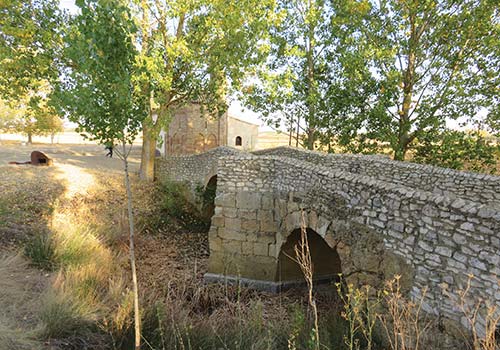
medieval bridge and hermitage, Ermita de la Virgen del Puente
An Augustinian pilgrims’ hospice in the Middle Ages, the Ermita de la Virgen del Puente has an interesting hybridized arch, part Mudéjar with a slight horseshoe shape, and part Gothic pointed arch. The hermitage is only open in summers and on feast days. Until the 1990s, its caretaker and guardian, known by everyone as Paca (her actual name was Julia Tovar), was a force of energy, kindness, and willpower who cared for the chapel as if it were her own home. Paca has since passed, but her granddaughter carries on the family dedication to the hermitage, though the municipality in Sahagún now holds the keys and sees to the upkeep of the place. The image of the Virgen del Puente that once stood on the altar is now kept in the Iglesia de San Juan in the center of Sahagún. From June-August, the hermitage is open daily with an enthusiastic local on hand who enjoys sharing the hermitage’s history.
Sahagún (pop. 2,597) is a large town that seems to combine all the joys of close-to-the-land village life with the ease and amenities of city life. If you join the locals for a drink on the Plaza Mayor, you’ll begin to feel a harmony here. Sahagún has not lost itself to the glories of its past, nor to existing only for the pilgrim trade. Commerce, agriculture, tourism, and jobs in nearby León keep the town vibrant.
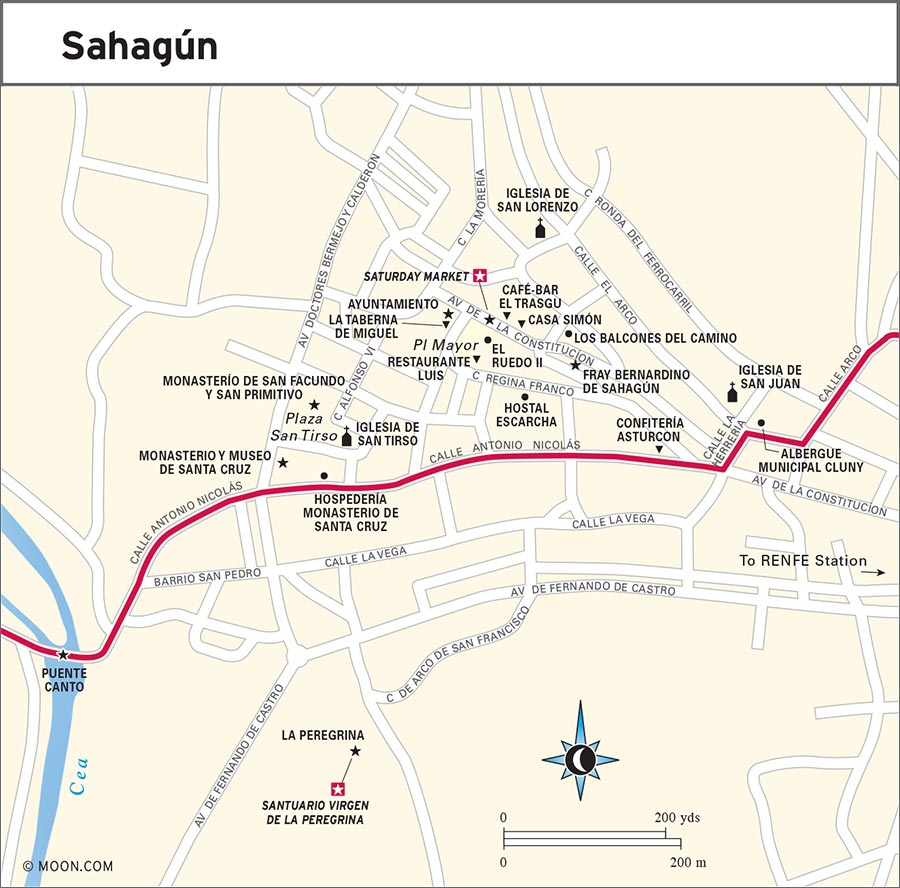
And though it seems like a quiet outpost in Castile today, in the 11th and 12th centuries Sahagún’s Benedictine monastery, San Facundo y San Primitivo, was one of the most powerful in Spain. Hints of that past are still here, with a remarkable collection of Romanesque-Mudéjar churches, from the ruins of the monastery to the Santuario de la Peregrina on the small hill just 600 meters (1,969 feet) due south of the Plaza Mayor near where the Camino passes through town. (It is here where you can get your midway certificate of walking, if you began the Camino in Saint-Jean-Pied-de-Port.)
Stop by the city hall, the Ayuntamiento, on the Plaza Mayor, for practical information, such as bus and train schedules.
As the Camino makes its way into the center of Sahagún, to its north are the Iglesia de la Trinidad, now the popularly called “four-star” municipal albergue, and next to it, the 17th-century Neoclassical Iglesia de San Juan, which holds the tombs of San Facundo and Primitivo. A little farther west from here is the Iglesia de San Lorenzo and the Plaza Mayor. The Santuario de la Peregrina is a slight detour south off the Camino’s trajectory through town, and then the Camino passes directly by the Iglesia de San Tirso, the Monasterio de San Facundo y San Primitivo, and the Monasterio de Santa Cruz. The Camino then wends farther to the west to the Río Cea, the site of Facundo and Primitivo’s 4th-century martyrdom, today traversed by the sturdy and lovely Puente Canto, a bridge built in 1085 under Alfonso VI’s patronage.
Sahagún’s name comes from San Facundo, one of two brothers—Facundus and Primitivus—who were martyred here in AD 303 by Romans, who killed them by throwing them the nearby Cea river. The 17th-century Neoclassical Iglesia de San Juan (Calle del Arco; 987-780-001) is where the tombs of the two brothers are kept, as well as the image of the Virgen del Puente. The interior is fairly modern, with a strong Neoclassical style. The church opens for daily mass at 10am and 8:30pm and is otherwise closed except on festival days.
Founded in the early 12th century, if not earlier, the present form of Iglesia de San Lorenzo (Plaza de San Lorenzo, s/n; 987-780-001; www.villadesahagun.es) is a mix of Romanesque, Mudéjar, and Gothic from the early 13th century. The arcaded porch is one of its prettiest features, along with the three-dimensional lattice-like brickwork. At night, floodlights on the square illuminate the church, highlighting the geometric lines and blind arches formed by the brickwork.
The weekly market sets up in the early morning on Saturdays along the Avenida de la Constitución and Plaza Mayor, and brings a color and dynamism to the town that comes closer than anything else to capturing the medieval glory of the place as a market center. Perhaps not as bustling as then—with its Jewish, Muslim, Christian, and Frankish residents—it is still rich in the produce of the land. Not only will you see amazing produce just plucked from Sahagún’s kitchen gardens and fields, but you can sample local cheeses, cured meats, pastries, and breads, and also soak up the array of terracotta cooking dishes, kitchen utensils, textiles, shoes, jewelry, and toiletries. Surrounding businesses also seem to come more to life during the market when the whole community is there, pausing for a drink on the main square. This is one of the best weekly markets on the Camino and can be combined with a day of sightseeing in Sahagún, the red brick churches being but a few paces away (and open).
A statue of Fray Bernardino de Sahagún (AD 1499-1590), a missionary and historian from Sahagún who was sent to the New World and who is considered Spain’s first anthropologist (given his careful ethnographic study of the Aztecs), overlooks the market from his pedestal on the Avenida de la Constitución.

Plaza Mayor in Sahagún
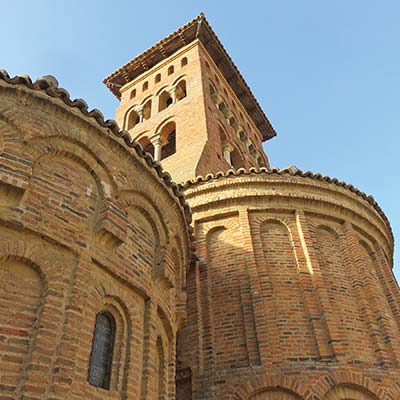
Mudéjar brickwork on the apse of Iglesia de San Tirso in Sahagún
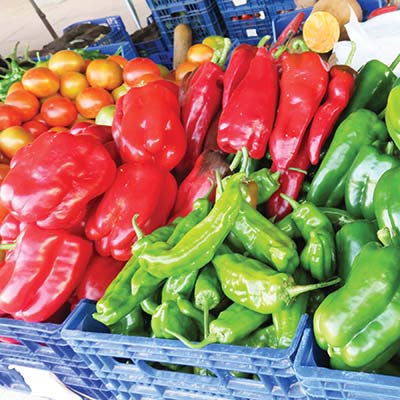
garden harvest for sale at Sahagún’s Saturday market
The Iglesia de San Tirso (Plaza de San Tirso, s/n; 987-780-001; www.villadesahagun.es; Oct.-Mar. Wed.-Sat. 10am-2pm and 4-5:50pm, Sun. 10am-2pm; Apr.-Sept. Wed.-Sat. 10am-2pm and 4-8pm, Sun. 10am-2pm) was built either in the later 11th or early 12th century. Similar to San Lorenzo, it has the classic Romanesque-Mudéjar triple apse and geometric brickwork. Along the triple naves are a wonderful collection of tabletop three-dimensional architectural models of Sahagún’s medieval churches. Among them is an ambitious reconstruction of the Monasterio de San Facundo y San Primitivo. You may want to take this in before you investigate the ruins of the monastery next door.
The central altar’s hybrid horseshoe and Romanesque arch is of a height and width that makes it feel as if you are being embraced warmly and invited to sit and meditate. Inlaid in the floor before it is a six-pointed star of brick with black and white stone. This is a common decorative element in Christian, Islamic, and Jewish art and architecture and represents the Seal of Solomon, a symbol of balance, wisdom, and justice. (The Star of David is an association that became more common in the 19th century.) It’s a great reminder both of Sahagún’s tri-religious past and of the common source tradition of all the Abrahamic faiths.
A portion of the church and a few standing walls are all that survive of this once powerful monastery (Plaza de San Benito, 1; 987-780-001; www.villadesahagun.es), built mostly in the 11th to 13th centuries over its earlier Visigothic foundations. But the town has built itself onto these walls, and there is a romantic continuity of past to present. Once, a resplendent Romanesque-Mudéjar complex stretched across a good portion of what is now a park, parking lot, and streets around the current monastery ruins, but much of that structure was destroyed in 1812 by Napoleon’s troops. Today, the ruins still offer a romantic pose, especially if you visit at night, when they (and the Iglesia de San Tirso next door) are illuminated with floodlights.
The former monastery church bell tower, now the town’s clock tower, is a modern construction from 1835. The town has gradually been restoring the Gothic monastery church, and though it still looks like a ruin, the progress has been immense. The large arch over the street next to the ruins, the Arco de San Benito, marks where the original front of the monastery was, but it too is a more modern overlay, from 1662. Hidden on its backside are a few elements from the earlier Romanesque building—a portion of a column and its capital and two round windows.
The most moving part of the Monasterio de Santa Cruz (Avenida Doctores Bermejo y Calderón, 10) is its daily mass at 8:30am (9am on Sundays) and Vespers at 7pm, where sacred song is a part of the prayer service. The monastery is largely rebuilt and more modern than its late 12th-century founding. It has an important sacred art museum, Museo de Santa Cruz (987-780-078; www.monasteriosantacruz.es; Sun.-Thur., 10:30am-1pm and 4-6:30pm; €2). You can sleep here as a pilgrim in wonderful lodging newly taken over by the Padres Maristas, Marist Fathers, an order of men devoted to being the charismatic presence of Mary on earth.
Santuario de la Peregrina (987-780-001; www.villadesahagun.es; Mon.-Sun., 10:30am-2pm and 4:30-8pm; €3) was founded in 1257 as a Franciscan monastery, but restoration work in the latter half of the last century uncovered lacey and pigmented Mudéjar lattice work under a coat of plain plaster, revealing the greater beauty of the monastery in the Middle Ages. Careful restoration has brought to light the larger extent of this mixed Gothic and Mudéjar (with pinches of Romanesque) monastery.
Not only is this a gem of Mudéjar artistry, this sanctuary houses La Peregrina, a 17th-century statue of Mary on the altar who is dressed as a traveling pilgrim with cape, sun hat, staff, and water gourd. She is the whole point: medieval legend, as captured in Alfonso X’s 13th-century Cantigas de Santa María (song #49), recorded that pilgrims arriving in Sahagún after nightfall encountered a woman on the road, her staff aglow with light, who would meet them and lead them to shelter. (If her statue is not here when you visit, you’ll find it in the museum of the Monasterio de Santa Cruz.)
This is also where pilgrims receive their halfway Camino certificate.
In addition to its Saturday market, Sahagún has a rich cycle of festivals throughout the year (www.aytosahagun.es/turismo-y-ocio/ferias-fiestas-y-tradiciones). Some of the most colorful include: The Fiesta de la Virgen de la Peregrina, every July 2, with processions, traditional folkloric groups, bonfires, and festive foods; the local pilgrimage, Romería de la Virgen del Puente in April, which is unofficially called the Romería del pan y queso, bread and cheese pilgrimage, a celebration of the produce of the land and of spring; and every June 12-13, the Fiesta de San Juan de Sahagún, a celebration of the town’s patron saint.
Several cafés line the Plaza Mayor, which is a lively spot for a drink, especially on pleasant evenings when you can take a seat at one of the outdoor tables, such as at the Restaurante Luis or the Taberna de Miguel.
S Casa Simón (Avenida de la Constitución, 47; 987-780-917; www.casasimonsahagun.com; €8-15) can get crowded any night of the week, but there is also a dining area in back, with large windows letting in light from the other side of the building. It is a popular raciones (tapas) and picoteo (pinchos bar) joint, as well as a place to get a good menú del día or graze a la carte. Among their signature dishes are croquetas, braised leeks with cecina (dry-cured beef), and chorizo grilled with pimientos de Padrón (tiny green peppers from Galicia). They have an excellent wine list.
Café-Bar El Trasgu (Avenida de la Constitución, 45; 987-782-011; under €10) is named after the house elf, el trasgu, common to Asturian, Castilian, and Leónine folklore, who is known to help as much as to cause charming bits of mischief. The owner is Asturian and offers inexpensive, tasty, and creative mischief in the form of generous tapas (raciones), good pizzas, and paella.
For excellent coffee and some of the best pastries on the Camino, stop at S Confitería Asturcon (Avenida de la Constitución, 62; 987-780-343; €2.50), a great place for a snack or breakfast. All their baked goods are made on the premises, including croissants, rolls, and fruit- or chocolate-filled pastries. (A personal favorite: the flakey, custardy, open-faced apple tart.) The owner is cheerful and welcoming, no matter how many people are clamoring at the counter for treats. There’s some café seating inside and a wonderful triangular raised terrace on the Camino outside.
Restaurante Luis (Plaza Mayor, 4; 987-781-085; €12-20) is an institution, serving the same high-quality cuisine over recent decades, both of the local Tierra de Campos as well as with a strong Basque culinary influence. Among the specialties are roasted suckling pig, foie gras, bean stews, and grilled cod and tuna, as well as homemade tarts.
A very good restaurant—also with a good quality lodging on the upper floors—Restaurante El Ruedo (Plaza Mayor, 1; 987-781-834; www.restauranteelruedo.com; €11) prides itself on its modern interpretations of classic regional dishes, all made from seasonal, locally grown ingredients. A house specialty: roasted lamb and braised leeks. With a great location on the main square where the whole community aggregates, you can linger here deep into the night and be a part of local life.
La Taberna de Miguel (Plaza Mayor, 12; 987-781-162; €10) is located in a peaceful corner on the other side of the Plaza Mayor, next to the city hall, the Ayuntamiento. Come here to enjoy a glass of regional wine and pincho (€2.5-3) at an outdoor table under dappled shade from the square’s plain trees. The interior dining room is entirely wood—bar, floors, tables, some with communal benches—giving a fun rustic tavern feel. Meal specialties include pastas and grilled steaks.
A modern building done in the red brick Mudéjar style, S Los Balcones del Camino (Calle Juan Guaza, 2; 987-780-145 or 676-838-242; www.losbalconesdelcamino.es; five rooms, three with private bath; €35-60) is a home converted into a small rural hotel that feels as if you are time-traveling to the Belle Époque. Gorgeous wood and inlaid painted-tile floors and stairways accentuate rooms and passageways. A large group can rent the whole house (€260 for the weekend). Hostess Carmen offers warm and helpful reception. The one drawback can be the noise from the street, so weekends might be less peaceful than weekdays.
Hostal El Ruedo II (Plaza Mayor, 1; 987-781-834; www.restauranteelruedo.com; €32-52) is centrally located, with spacious, spotless, and comfortable rooms. A very good restaurant on the ground floor, Restaurante El Ruedo, serves seasonal and local fare.
The central Hostal Escarcha (Calle Regina Franco, 12; 987-781-856; www.hostalescarcha.com; €20 single, €40 double) is among Sahagún’s best deals, on a quiet side street, a delightful family-run hostal with clean, basic rooms with ensuite bath. A few paces from the Plaza Mayor for food and drink, the ground floor also has a bar that leads out to a courtyard terrace.
S Albergue Municipal Cluny (64 beds; €5; open year-round), located in the beautifully restored 16th-century Iglesia de la Trinidad, has been called a “four star” albergue. Built from the familiar warm brick of Sahagún, they’ve crafted a light-filled and airy interior, with open stairways, high ceilings, and comfortable bunk beds set in private partitions. It feels like as if you are stepping into a medieval M. C. Escher print, especially when you look up at the stairways and beams. The albergue actually shares part of its building with a music hall, and when there are concerts, resident pilgrims get to attend for free, many just enjoying the music from their beds!
In 2018, the Marist Fathers took over running the already good S Hospedería Monasterio de Santa Cruz (Calle Antonio Nicolás, 40; www.alberguesensahagun.es; 50 beds) and made it excellent, with pristine rooms most with two or four beds per room and some with six or eight; each room has its own ensuite bath. (They request a minimum donation of €5, but if you can afford more, that would be nice.) They offer a communal dinner (also donation), a mass, and above all, the hope that people will feel welcome here and enjoy “a chance to return to the roots of the Camino,” with an emphasis on spirituality and service.
Sahagún is connected by train from Barcelona, Madrid, Burgos, and León, the last being the most efficient and direct travel hub. The most direct bus conection to Sahagún is from Madrid.
RENFE (www.renfe.es) runs trains from Barcelona (three daily, 7-9 hours, €62-88), Madrid (four daily, 4-5 hours, €35), Burgos (three daily, 1.5 hours, €17), and León (eight daily, 40 min., €6-12).
Sahagún’s train station, Estación de Renfe (Calle de la Estación, s/n) is 800 meters (0.5 mile) east of the Plaza Mayor in the center of town and a direct 10-minute walk along Calle de la Estación and Avenida de la Constitución.
ALSA (www.alsa.es) has one bus daily from Madrid (Madrid Estación Sur; 4.5 hours; €23) to Sahagún. There is no official bus station in Sahagún; the main stop is on the outskirts of town near the Hotel Puerta (Carretera de Burgos, 11), which the Camino passes behind (to the right of the hotel), 1 kilometer (0.6 mile) east of the center and a 15-minute walk west to Sahagún’s central Plaza Mayor.
If you need a cab, call Taxi Mary (630-437-921), Taxi Fede (639-943-349), or Taxi Almudena (669-797-769).
Four kilometers (2.5 miles) after leaving Sahagún, you have a choice: Stay on the medieval route, known as the Camino Real, or detour to the Via Romana—also called the Calzada Romana and the Via Trajana/Via Traiana—which follows the old Roman road that parallels the Camino Real a few hundred meters to the north, adding a little over 1 kilometer (0.6 miles) to the whole trek. You won’t see much of the Roman road; it is largely under dirt and gravel. The advantage of this detour is to get a little farther away from the highway (A-231) that the Camino Real parallels in places. Be prepared with both choices: Both paths have long stretches where there are no support services of food, water, or lodging, 12.9 kilometers (8 miles) on the Camino Real and 17.7 kilometers (11 miles) on the Via Romana.
The Camino Real continues on to Bercianos del Real Camino. One reason to stay on it is to see the 17th-century hermitage, Ermita de Nuestra Señora de Perales (Km 354.9; Lugar Diseminado, 4, Bercianos del Camino; 987-784-179; June-Sept. 11am-1pm and 6-8pm; free) just before this village. Both a rest area and sacred site for the people of Bercianos, it houses the village protectress, Nuestra Señora de Perales, Our Lady of Pear Trees. It dates back at least as far as the 12th century, when it was attached to a pilgrims’ hospital run by monks from Cebreiro. Now, you may find an elderly couple, current guardians in a long line of caretakers, who visit the shrine frequently with their grandchildren to greet and offer information to pilgrims passing through. Consider stopping to take in the red brick and stucco hermitage, to see Our Lady of Pear Trees on the altar, and enjoy the cool interior. Its angled terracotta roof and arched bell tower rising above the wheat field in the meseta has a magnetic pull. This is the site of village festivities and romerías—village processions—that take place in the spring and every September 8 to honor the Virgen de Perales.
 Detour: The Via Romana
Detour: The Via RomanaThis village (pop. 241) centers on the 17th-century brickwork Iglesia de San Esteban and on a shrine dedicated to San Roque, patron of pilgrims as well as protector against disease and disaster, a win-win for peregrinos and locals alike.
Stock up on provisions in the Bar Xanadu (Calle Real, 84; 696-881-411) if you are continuing to Calzadilla de los Hermanillos, 8.5 kilometers (5.3 miles) away. Xanadu offers a good menú del peregrino with the usual suspects: grilled meats, fried eggs, and good local wines. The one lodging choice here is the clean and modern municipal Albergue San Roque (Calle Real; 987-781-233 or 674-587-001; www.aytocalzadadelcoto.es; open year-round, 36 beds; donation), which has a shared kitchen.
The parish church of this village (pop. 141) is San Bartolome, a sturdy 16th- and 17th-century structure that replaces what might have been an earlier Visigothic or Mozarabic (Christians coming from Muslim Iberia) church on the spot.
The stylish, family-run brick and stucco Albergue Via Trajana (Calle Mayor, 55; 987-337-610; www.albergueviatrajana.com; Apr.-Oct.; five double rooms with private bath, €35-40, three dorm-style rooms, €15) also has a restaurant that serves a menú del peregrino as well as combined plates of grilled meat, fries, and salad.
Another nice option is the family-run rural guesthouse, Casa El Cura (Calle Carretera, 13; 987-337-647; €55), set off on the edge of the village and surrounded by countryside, where you can get meals and lodging (seven different rooms with private bath) while relaxing in the garden, terrace or lounge.
The municipal albergue (987-330-023; 22 beds; donation) is in the old school and features modern basic facilities and comfort (hot showers, a shared kitchen).
After 17.7 kilometers (11 miles) with no support services in between, you arrive at Reliegos (Km 333.7). You can either rejoin the Camino Real here, or stay on the Via Romana another 6 kilometers (3.7 miles) to rejoin the Camino in Mansilla de las Mulas (Km 327.4).
Berciano refers to the people from the El Bierzo region of León who settled this village (pop. 193) in the Middle Ages. The church, Iglesia del Salvador, lost its tower—it collapsed—in 1998, but the church is still there, as well as a beloved village chapel dedicated to pilgrim and protector, San Roque.
The Hostal Rivero (Calle Mayor, 12; 987-784-287; www.hostalrivero99.wixsite.com/hostal-rivero; €30-45) has eight private rooms with bath and also serves a three-course menú (€10).
The bar and hostal El Sueve (Calle la Iglesia, 21; 987-784-139) takes pride in serving delicious food, including a menú del peregrino (€9), and offers four comfortable and peaceful rooms (€30-45).
The Albergue Santa Clara (Calle Iglesia, 3; 605-839-993; alberguesantaclara@hotmail.com; year-round) offers two dorm rooms (10 beds total, €8/bed) and four private rooms (€25-30); try to get one of the private rooms as the dorm is a bit cramped. The reception here is very welcoming and the spaces clean and modern.
Some say El Burgo Ranero (pop. 220) gets its name from el burg granero, a grain or granary town, and others from el burgo ranero, a place abundant with frogs (ranas), a part of the town legacy thanks to the nearby pond. Take your pick; they’ve got plenty of both. The frogs add a nice touch, ribbiting along the small lagoon on the northwest side of town, especially at dusk as the sun begins to set on a hot, dusty day.
El Burgo Ranero’s industries, outside of pilgrimage, are wheat and sheep. The village probably came into being in the early 12th century, but is set on a much more ancient pathway where sheep have been moved from pasture to pasture over millennia. (Shepherding and trans-humance—a word we get from Spanish, the practice of moving sheep from summer to winter pastures and back again—have been practiced here ever since the first farmers and herders inhabited Iberia.)
El Burgo Ranero’s accommodations and shops are on the north side of the village, off the Camino trail, but as you walk in—just before the sweet brick, stone, and clay village church of San Pedro—you’ll pass a few eating options. One in particular, S La Costa del Adobe (Calle Real, 79; 649-287-580; €9-12), is run by an idealistic and energetic English-speaking couple who work to procure and prepare local, organic, and sustainable foods and to accommodate all dietary needs. Dishes are innovative and traditional at once, such as a grilled vegetable platter, homemade thin crust pizza, and the house specialty, tortilla guisada, Spanish omelet stewed in a terracotta dish in a rich tomato and pepper sauce. They also make their own ice cream.
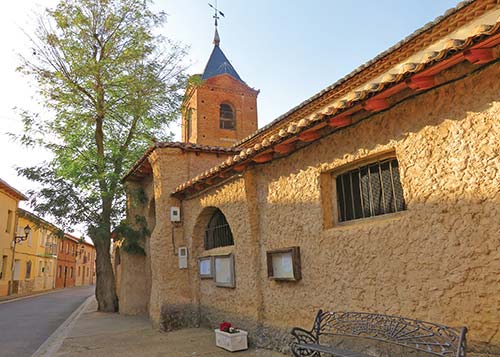
El Burgo Ranero’s main street, also the Camino, and village church.
On the north side of town, near the road that leads to the train station, two excellent lodging choices stand side-by-side: The Hostal Restaurant El Peregrino (Calle Fray Pedro del Burgo, 36; 987-330-069) and the Hostal Piedra Blanca (Calle Fray Pedro del Burgo, 32; 987-330-094; www.hotelruralpiedrasblancas.com) offer the same good value, cozy and spotless rooms. Each has 10 rooms with bath to let for €30-45. Both are family run, and each has an animated bar (where locals play cards, dominoes, and board games) and dining area, offering good pilgrim menus (€10), refreshments, and snacks. Locals laud both hostales’ restaurants, especially El Peregrino’s, as the places to go for traditional, family-style meals.
Across the street from the hostales is the Albergue Domenico Laffi (987-330-023 and 987-330-047; elburgoranero@gmail.com; 30 beds in four rooms; donation), named after the 17th-century Italian pilgrim who stayed here and who also wrote a colorful account of the Camino, A Journey to the West. The volunteer hospitaleros offer helpful and warm reception in a cheerful two-story building with small, spacious, well-kept dorm rooms. It is open year-round; if no one is there to greet you from Nov-Mar., ask for the key at the general store across the street.
El Burgo Ranero is a rare transport hub along this stretch of the meseta. Every Mon., Wed., and Fri. morning, one ALSA (www.alsa.es) bus connects El Burgo Ranero to León (45 min., €4) with stops in Puente Villarente, Arcahueja, and Mansilla de las Mulas. RENFE (www.renfe.es) also runs trains to León (two daily, a morning and an afternoon train, 30 min., €4). Schedules for both bus and train are posted on the bulletin board inside the Albergue Domenico Laffi. If walking, stock up on water and food; the 12.9 kilometers (8 miles) to Reliegos have no support services.
The modern village of Reliegos (pop. 176), a former Roman village that was resettled in the 10th century, has few vestiges of its past (though you can see many wonderful private family bodegas tucked into the hillsides like Hobbit holes), but offers a good place for food and accommodation. The Via Romana rejoins the Camino Real here.
For its size, Reliegos has a large array of lodging, some six albergues and three hostales and inns.
Albergue Vive Tu Camino (Calle Real, 56; 610-293-986 or 670-885-959; www.alberguevivetucamino.com) offers clean and simple living spaces, with a shared dining area and kitchen, a peaceful garden, and dorm-style sleeping (€9 for each sturdy and new wooden bunk bed) and private rooms (€35-50).
La Parada (Calle Escuela, 7; 987-317-880; alberguelaparada@gmail.com) has a great terrace centered around a traditional well and has all facilities and options, including a shared kitchen, small store, restaurant and bar (dinner menu, €10). Lodging options are two private rooms (€30) or 36 beds in six dorm rooms (€7).
Mansilla de las Mulas (pop. 1618) makes a strong impact on the horizon, its dense town walls—3 meters (nearly 10 feet) thick in some places—enclosing the medieval center. Those walls were first laid down in Roman times, when this was a stopping place on the Via Trajana (Via Traiana) destined for León. King Fernando II of León reinforced the walls and town in the 11th century; they were fortified again in the 13th and 14th centuries. Some 75 percent of the walls survive, lending the town a romantic atmosphere.
In the Middle Ages, Mansilla’s economy, in addition to pilgrim commerce, was as a mule market (las mulas), which supplied the region with these all-important animals for labor and transport. Today, the old town is full of picturesque plazas (many of them concentrating along the west wall), pedestrian promenades, and riverside paths along the Esla river.
Every Tuesday, a food and general goods market sets up on the Plaza del Grano.
About 50 meters (164 feet) to the left of the Camino as it nears the medieval section of Mansilla de las Mulas, the Belle Époque 1898 stucco Ermita de la Virgen de Gracia (Plaza de Nuestra Señora de Gracia, 1; www.aytomansilladelasmulas.es) stands out for its bold striped cream- and red-painted walls. It may be a modern building, without too much to see inside or out, except that it houses the town’s most precious icon, the statue of Our Lady of Grace. The age of the sculpture is unclear, but it was restored in 1950 by the sculptor Victor de los Ríos after it was damaged in an earlier fire. But Mary of Grace, in earlier form, has been venerated here since 1220 (if not earlier), when it is documented that an older church dedicated to her stood here. The hermitage is rarely open, only for festival days. Since 1991, on the first Sunday in September, in honor of her feast day, locals (over 500 in recent years) make a pilgrimage from León’s Iglesia de Nuestra Señora del Mercado to this hermitage, an 18-kilometer (11.2-mile) journey, to lay at her feet offerings of flowers and fruits that they have grown on their own land. It is as much a harvest festival as a pilgrimage of gratitude for the abundance of the land and the season under the Virgen de Gracia’s protection throughout the year.
Iglesia de Santa María (Calle de la Concepción, 7; 987-310-019) is Mansilla’s oldest church. It has survived since 1220, while the other five churches from the 13th century have all but disappeared (except for the 13th-century bell tower that survives on the modern Iglesia de San Martín nearby). But even here, the church’s earlier medieval form was reformed in the 18th century. Santa María remains a house of worship. There is daily mass here at 8:30am, and Vespers at 8:30pm.
Learn about León province’s cultural traditions, festivals, folklore, and agrarian life at the Museo Etnográfico Provincial de León (Calle San Agustín, 1; 987-311-923; www.etnoleon.com; Tues.-Sat., Apr.-Oct., 10am-2pm and 5-8pm, Nov.-Mar., 10am-2pm and 4pm-7pm; €5). Exhibits include Guirrios, traditional Carnival regalia, complete with wonderful radiating psychedelic-patterned head gear.
S La Curiosa (Calle Jose Alvarez, 15; 608-880-588; www.lacuriosademansilla.com; €15-20) shows its innovative spirit in its name (“the curious”), taking traditional cuisine and adding modern, flavorful twists, such as scallops in blue cheese sauce, grilled hake and shrimp kebabs, and escarole with wild mushrooms. It’s set in a turn-of-the-century pharmacy building, and the original shelving in the bar displays a wonderful array of elixirs. This is one of the finest places to dine on the Camino.
Alberguería del Camino has an excellent restaurant connected to its hostal.
S Hostal Alberguería del Camino (Calle Concepción, 12; 987-311-193; www.albergueriadelcamino.com; €38-56) feels like a Leónese country inn set inside the old walls near the church of Santa María, with tasteful and impeccable rooms in solid wood and cast-iron furnishing. The rustic tavern-style bar and restaurant has several signature dishes (€9-13) dedicated to Mansilla’s local cuisine, including a leek tart and bacalao al Estilo de Mansilla (Mansilla-style cod that’s pan fried then stewed with garlic and spicy smoked paprika).
La Pension de Blanca (Avenida Picos de Europa, 4; 626-003-177; www.la-pension-de-blanca.negocio.site; €25-40) has seven eclectically decorated, neat, and colorful rooms.
Clean, well maintained, and upbeat, Albergue Gaia (Avenida Constitución, 28; 987-310-308; www.alberguegaia.com; €8; open Mar.-Jan.) was created by pilgrims-turned-hospitaleros Carlos and Marisa Fernández. They have 18 beds (all bunks) in two rooms with kiwi-green walls. There is a well-equipped kitchen for communal cooking and a shared dining area with an enclosed patio in back.
If you need a cab, try Taxi Mansilla (609-012-383; www.taximansilla.com).
If you want to bypass the heavily urban and industrial outskirts of León, ALSA (902-422-242; www.alsa.es) runs 11 buses daily from Mansilla de las Mulas (€1.65), Puente Villarente, and Villamoros de Mansilla (€1.40) to León.
Along the side of the N-601, 3.2 kilometers (2 miles) afer leaving Mansilla de las Mulas, a 1-kilometer (0.6-mile) detour to the right (just before the gas station Galp) leads to Yacimiento Arqueológico de Lancía (Villasabariego; 987-310-971; www.institutoleonesdecultura.es/EtnografiaPatrimonio/YacimientoArqueologicoLancia), the partially excavated ruins of the Roman settlement of Lancía. Visits inside the site are usually possible Mon.-Fri. mornings, but you can still see the site when it is closed, from the other side of the fence. The remains unearthed so far in this ongoing excavation are the thermal baths and the public market of the Roman town, which was established in the 1st century AD.
After visiting the site, you can backtrack to where you left the Camino, along the N-601, heading toward Villamoros de Mansilla (Km 323) and Puente Villarente (Km 321.5), leaving another 12 kilometers (7.5 miles) to León.
After Puente Villarente (Km 321.5, pop. 234), the stretch into León becomes increasingly industrial, and you may want to catch the bus from here into León to skip it. The settlements are more bedroom communities and feel rather desolate; the Camino passes near the busy road into León. If you decide to walk to León, Puente Villarente and Arcahueja offer some food and accommodation options. After leaving Arcahueja, 7.4 kilometers (4.6 miles) remain until León.
Albergue San Pelayo (Calle Romero, 9; 987-312-677; www.alberguesanpelayo.com; open year round) has a large garden and roomy interiors that can sleep up to 64 people (€8-10/bed) in four dormitory rooms and six private rooms (€30-40). Proprietors speak English.
Albergue El Delfin Verde (Calle Carretera General, 15; 987-312-065; www.complejo-el-delfin-verde.negocio.site; open Mar.-Nov.) has it all: a large swimming pool (in the summer), 15 private rooms (€25-40; breakfast is included), and 20 beds (€5) in three shared dorm rooms, plus a three-course evening meal (€10). Known for impeccable service and hospitality.
Hostal-Restaurante La Montaña (Calle Camino de Santiago, 17; 987-312-161; www.hostalrestaurantelamontana.es; 16 rooms; €30-45), on the west end of town, is a roadside inn with comfortable rooms and a decent restaurant and bar.
Bar-Restaurante Albergue La Torre (987-205-896; www.alberguelatorre.es; open year round) has a range of options, from two dorm rooms with 22 beds for €8/bed and four private rooms for €25-40. The bar restaurant serves a menú del peregrino (€9). Just beyond town, the roadside Hotel-Restaurante Camino Real (987-218-134; open year round; 44 rooms; €65) offers a decent menú and a la carte menu in the hotel restaurant (€13-18).